Inbox and Environment News: Issue 477
December 6 - 12, 2020: Issue 477
Parra'dowee Time
November-December
Goray'murrai—Warm and wet, do not camp near rivers
This season begins with the Great Eel Spirit calling his children to him, and the eels which are ready to mate make their way down the rivers and creeks to the ocean.
It is the time of the blooming of the Kai'arrewan (Acacia binervia) which announces the occurrence of fish in the bays and estuaries.
Acacia binervia, commonly known as the coast myall, is a wattle native to New South Wales and Victoria.
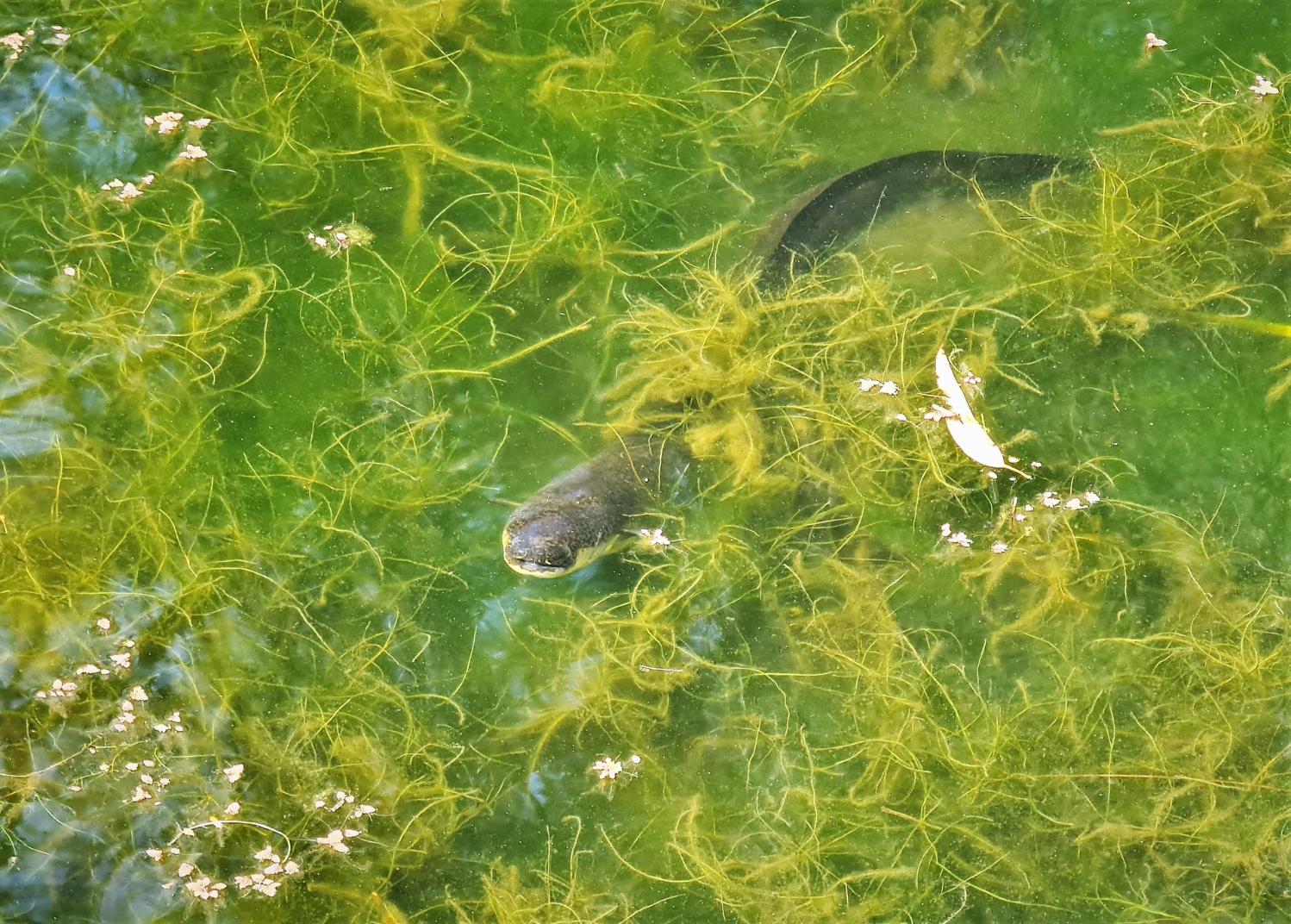
PITTWATER PATHWAYS DATA: Local Flooding 9 February 2020
Published December 2nd, 2020 by Pittwater Pathways
Moderately severe local flooding at Bayview, Narrabeen, Wakehurst Parkway and North Narrabeen.
New Northern Beaches Hospital cut off at Parkway.
This video made for data purposes.
More Trees Across Greater Sydney
December 1, 2020
New, green life will be breathed into Greater Sydney with more than 40,000 trees to be planted and a series of innovation projects delivered thanks to $10 million in NSW Government grants.
The Greening Our City program will provide grants to 30 councils and two partner organisations across two funding streams - Cooler Suburbs and Green Innovations.
Premier Gladys Berejiklian said the program would help reach her target to plant one million trees across Greater Sydney by 2022 and increase the proportion of homes in urban areas within 10 minutes’ walk of quality green, open and public space by 10% by 2023.
“This fantastic program will result in more than 40,000 trees being planted in the ground and will also see exciting innovation projects that protect native species and help to green urban spaces,” Ms Berejiklian said.
Minister for Planning and Public Spaces Rob Stokes said planting more trees would bring enormous environmental benefit while making public spaces more attractive.
“Our city is framed by parks – we know how valuable tree cover is for lowering heat, providing shade and enhancing our neighbourhoods,” Mr Stokes said.
“This program will see trees planted in more developed areas like Miranda and Parramatta and in growing areas like Camden, Blacktown, Campbelltown and Hawkesbury.”
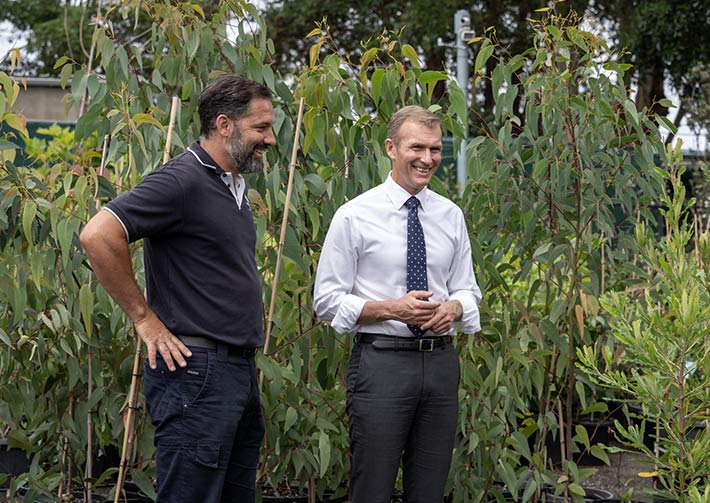
Local Government NSW President Linda Scott welcomed the announcement and said the program was a great example of partnership between local and State Government.
“Councils take a lead role cultivating healthy and sustainable environments for local communities and funding support is always welcome,” Cr Scott said.
Under the Cooler Suburbs stream, 29 local councils will receive more than $8 million in funding, supporting 39 tree planting projects that will add more than 40,000 trees to Greater Sydney.
The 12 projects to receive funding in the Green Innovations stream include:
- Planting 500 genetically diverse Camden White Gum within the Nepean River corridor at Camden South, a species listed as vulnerable;
- Transformation of a Penrith carpark into an open, green space;
- Revegetation of native trees and grasses across Randwick;
- A new state-of-the-art research facility and demonstration site testing the growth and performance of 48 diverse native and exotic tree species in the Hawkesbury.
The grant program is being administered by Local Government NSW on behalf of the Department of Planning, Industry and Environment.
A list of successful applicants is available at the NSW.gov.au website on the Greening our city page.
Stream 1 - Cooler Suburbs: Northern Beaches Council: Green canopy – Condamine St, Manly Vale - $121,000
Fledgling Kookaburra At Elanora Heights
photos by Selena Griffith
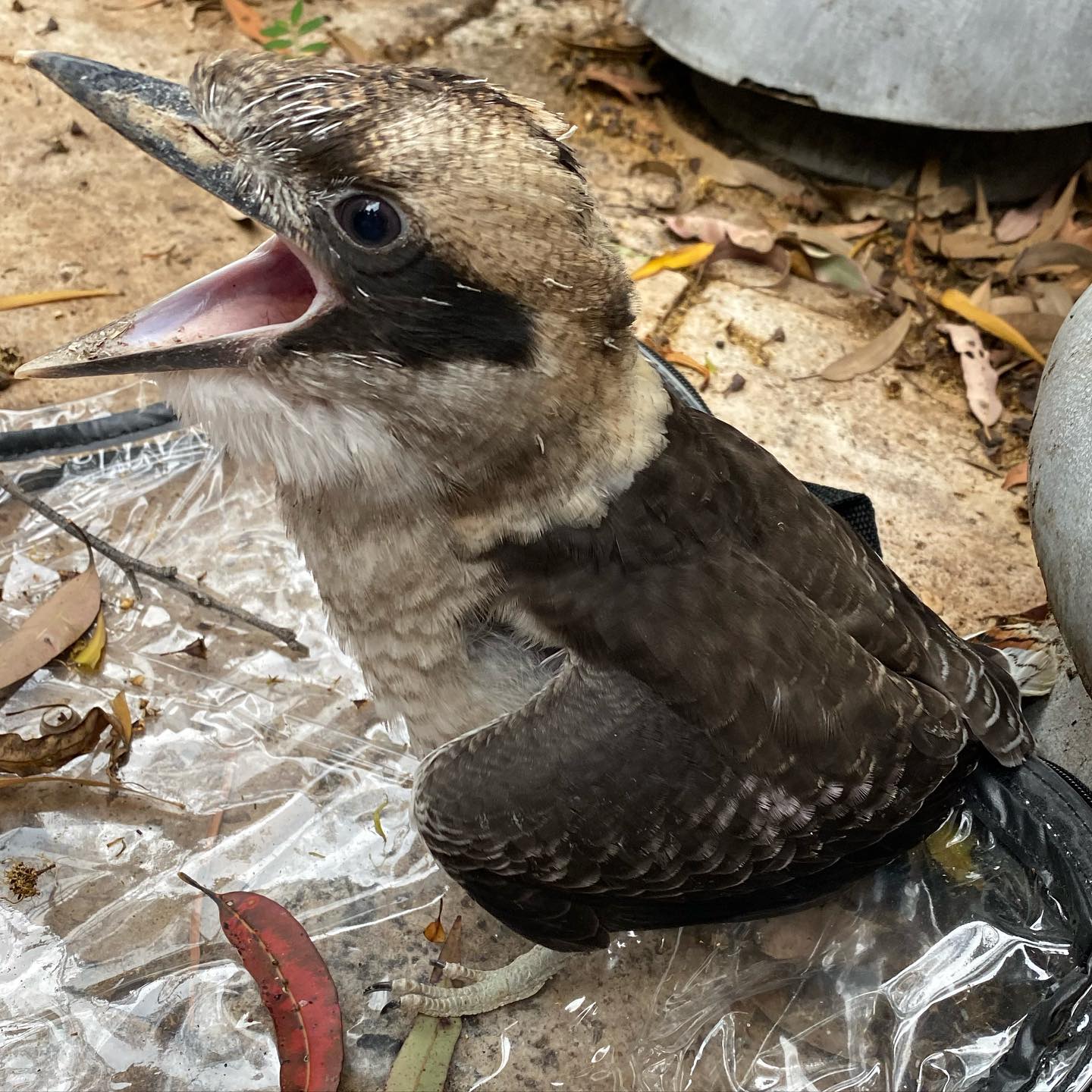
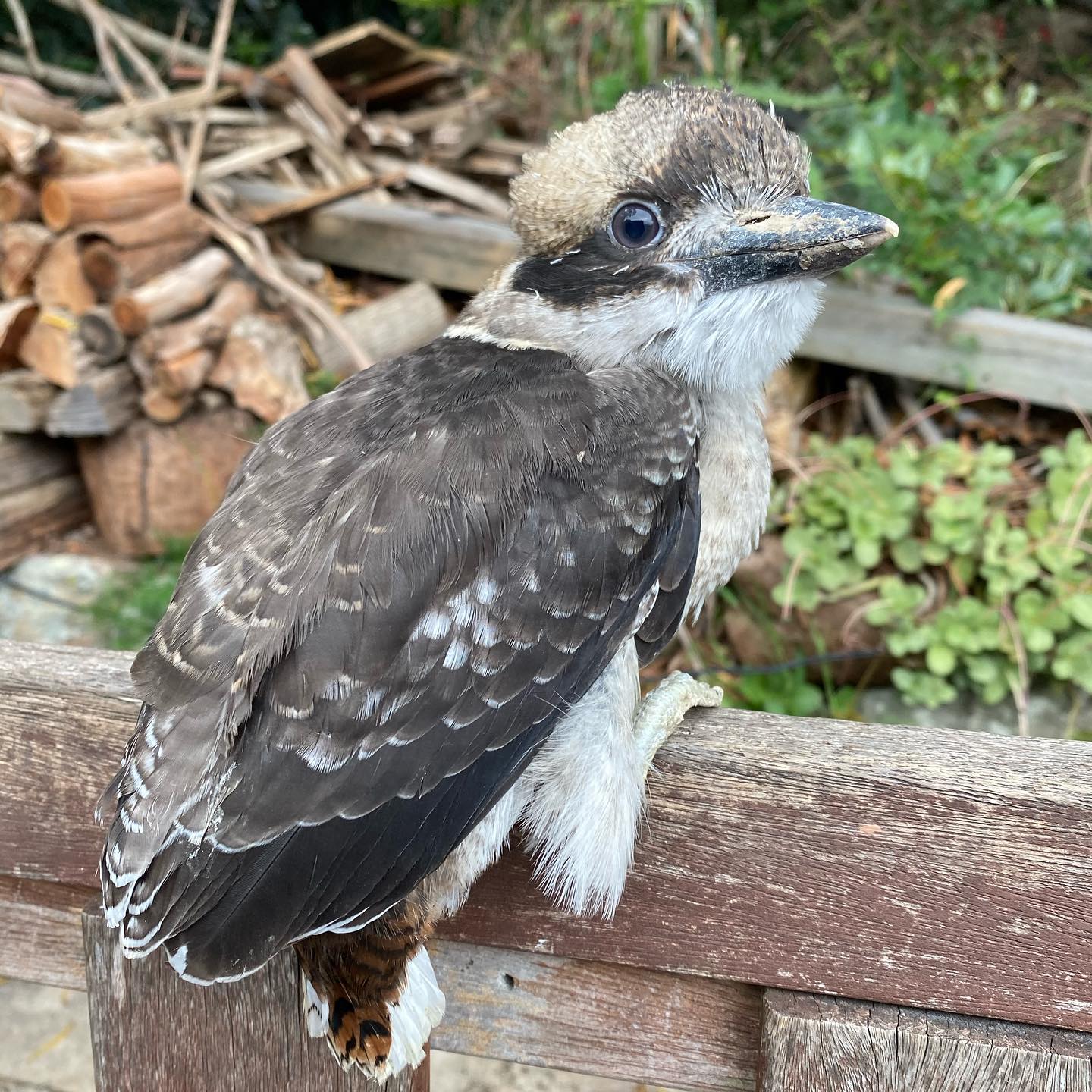
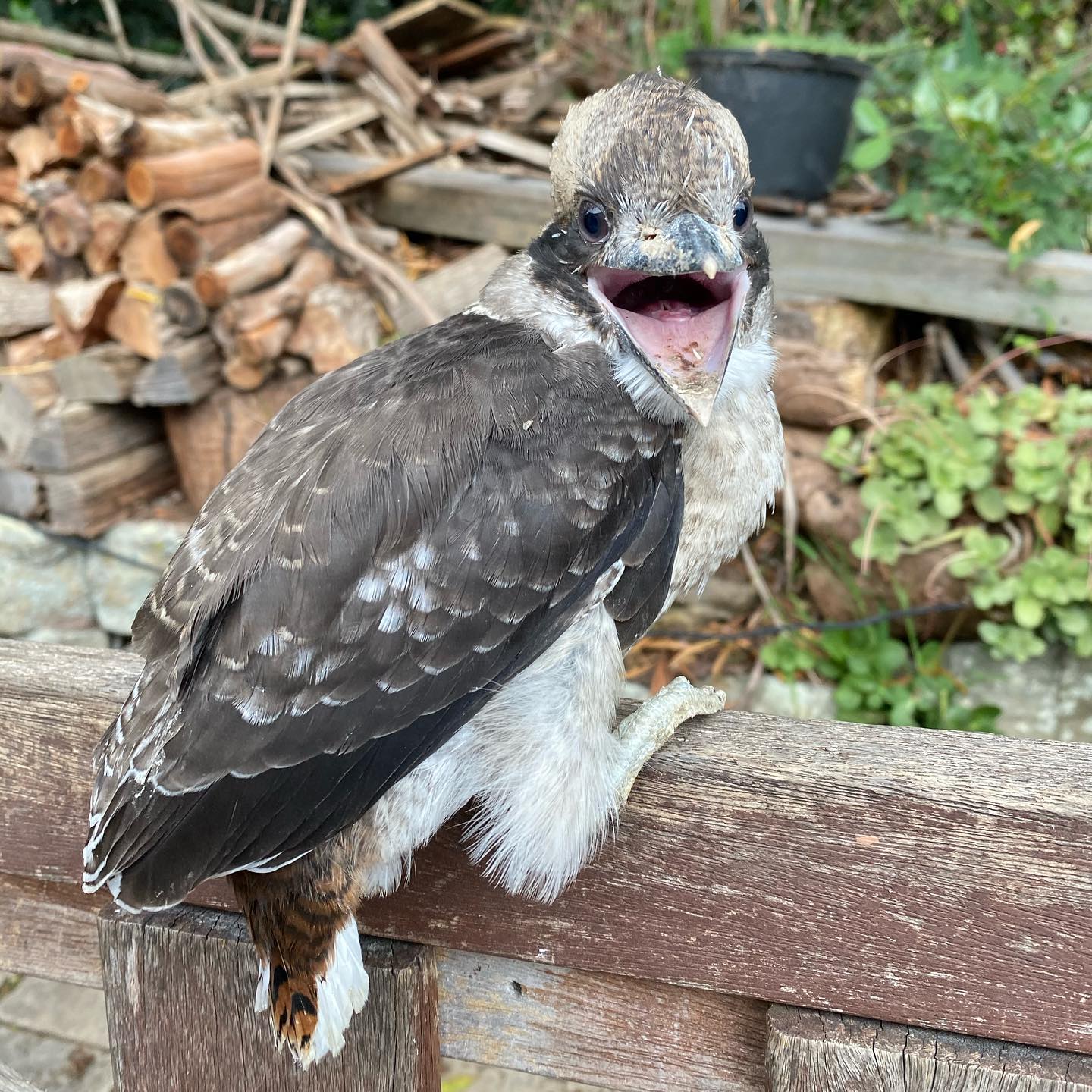
Watch Out On The Pittwater Estuary Water Zones & Beaches: Seals Are About
Residents have filmed and photographed the seals living at Barrenjoey as far south as Rowland Reserve and over at Clareville beach in recent days and ask that people keep an eye out for them and ensure they are kept safe from boat strikes and dogs are kept off the beaches they're not supposed to be on.
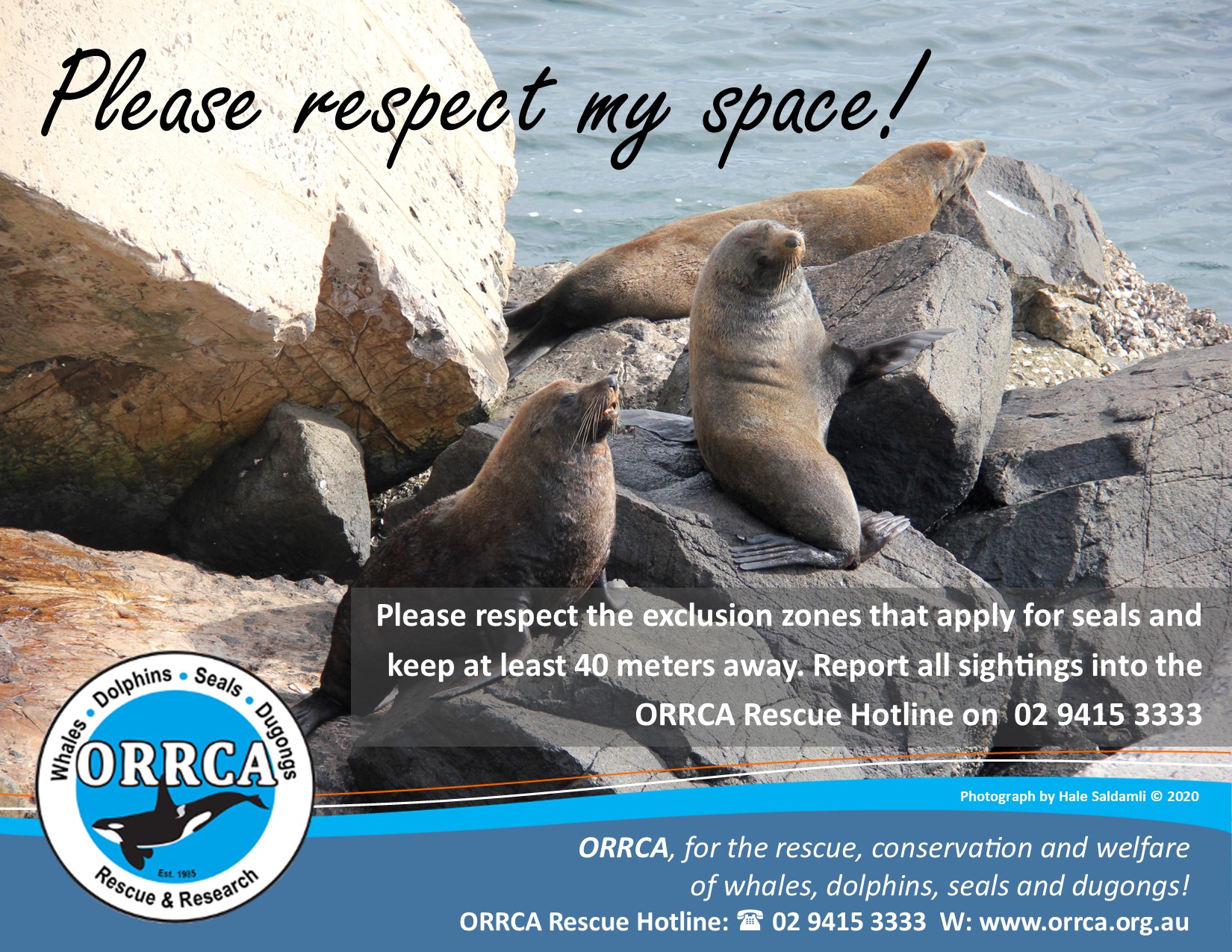
Can You Help Restore Our Environment? R&R Grants Open
Bushcare In Pittwater
Where we work Which day What time
Avalon
Angophora Reserve 3rd Sunday 8:30 - 11:30am
Avalon Dunes 1st Sunday 8:30 - 11:30am
Avalon Golf Course 2nd Wednesday 3 - 5:30pm
Careel Creek 4th Saturday 8:30 - 11:30am
Toongari Reserve 3rd Saturday 9 - 12noon (8 - 11am in summer)
Bangalley Headland 2nd Sunday 9 to 12noon
Bayview
Winnererremy Bay 4th Sunday 9 to 12noon
Bilgola
North Bilgola Beach 3rd Monday 9 - 12noon
Algona Reserve 1st Saturday 9 - 12noon
Plateau Park 1st Friday 8:30 - 11:30am
Church Point
Browns Bay Reserve 1st Tuesday 9 - 12noon
McCarrs Creek Reserve Contact Bushcare Officer To be confirmed
Clareville
Old Wharf Reserve 3rd Saturday 8 - 11am
Elanora
Kundibah Reserve 4th Sunday 8:30 - 11:30am
 Mona Vale
Mona Vale Mona Vale Beach Basin 1st Saturday 8 - 11am
Mona Vale Dunes 2nd Saturday +3rd Thursday 8:30 - 11:30am
Newport
Bungan Beach 4th Sunday 9 - 12noon
Crescent Reserve 3rd Sunday 9 - 12noon
North Newport Beach 4th Saturday 8:30 - 11:30am
Porter Reserve 2nd Saturday 8 - 11am
North Narrabeen
Irrawong Reserve 2nd Saturday 2 - 5pm
Palm Beach
North Palm Beach Dunes 3rd Saturday 9 - 12noon
Scotland Island
Catherine Park 2nd Sunday 10 - 12:30pm
Elizabeth Park 1st Saturday 9 - 12noon
Pathilda Reserve 3rd Saturday 9 - 12noon
Warriewood
Warriewood Wetlands 1st Sunday 8:30 - 11:30am
Whale Beach
Norma Park 1st Friday 9 - 12noon
Western Foreshores
Coopers Point, Elvina Bay 2nd Sunday 10 - 1pm
Rocky Point, Elvina Bay 1st Monday 9 - 12noon
Gardens And Environment Groups And Organisations In Pittwater
Grants To Fund Innovative Re-Use And Recycling Projects
The NSW Environment Protection Authority (EPA) is calling for innovative and new projects looking for ways to re-use discarded materials to make new products or for new uses, and for construction projects that want to re-use materials like construction waste, glass or plastic, to apply for new grants to help create a circular economy.
New intakes for the EPA’s Circulate and Civil Construction Market Programs are now open and aiming to divert valuable materials from landfill for re-use, recycling and industrial ecology projects.
The grant funding helps organisations including businesses, councils, not-for-profits, waste service providers and industry bodies, among others, design projects that promote the circular economy, instead of a disposable culture.
EPA Director Circular Economy Programs Kathy Giunta said these programs will provide grant funding to support industry to respond to the decision by the Council of Australian Governments (COAG) this year to ban the export of certain wastes that have not been processed into value-added material.
“One of the ways to mitigate the effects of China’s National Sword policy and to prepare NSW for the waste export ban is to invest in projects that demonstrate innovative uses of recyclables,” Ms Giunta said.
“The Circulate Program provides grants of up to $150,000 for innovative, commercially-oriented industrial ecology projects. Circulate supports projects that will recover materials that would otherwise be sent to landfill, and to instead use them as feedstock for other commercial, industrial or construction processes.
“The Civil Construction Market Program provides grants of up to $250,000 for civil construction projects that re-use construction and demolition waste or recyclables from households and businesses such as glass, plastic and paper.”
Previous projects in the Circulate Program include Cross Connections’ Plastic Police, which supplied soft plastics to the Downer Group’s Reconophalt project, the first road surfacing material in Australia to contain high recycled content from waste streams, also including glass and toner, which would otherwise be bound for landfill or stockpiled.
Previous projects in the Civil Construction Market Program include supporting Lendlease’s use of recycled glass from Lismore Council in pavement concrete on three trial sites as part of the Woolgoolga to Ballina Pacific Highway Upgrade.
Applications will be open until Friday 12 February 2021.
For details of the grants and how to apply, visit epa.nsw.gov.au/circulate and epa.nsw.gov.au/working-together/grants/business-recycling/civil-construction-market-program-grants
New Parks Protecting Ancient Culture
December 1, 2020
The NSW Government is handing back more than 15,000 hectares of land to Aboriginal owners in the State’s central west which will be reserved to form the new Mt Grenfell National Park and the Mt Grenfell State Conservation Area.
The new National Park and State Conservation Area will add 15,285 hectares to the existing Mt Grenfell Historic Site effectively forming a protective ring around some of the most significant Aboriginal art and cultural sites in Australia.
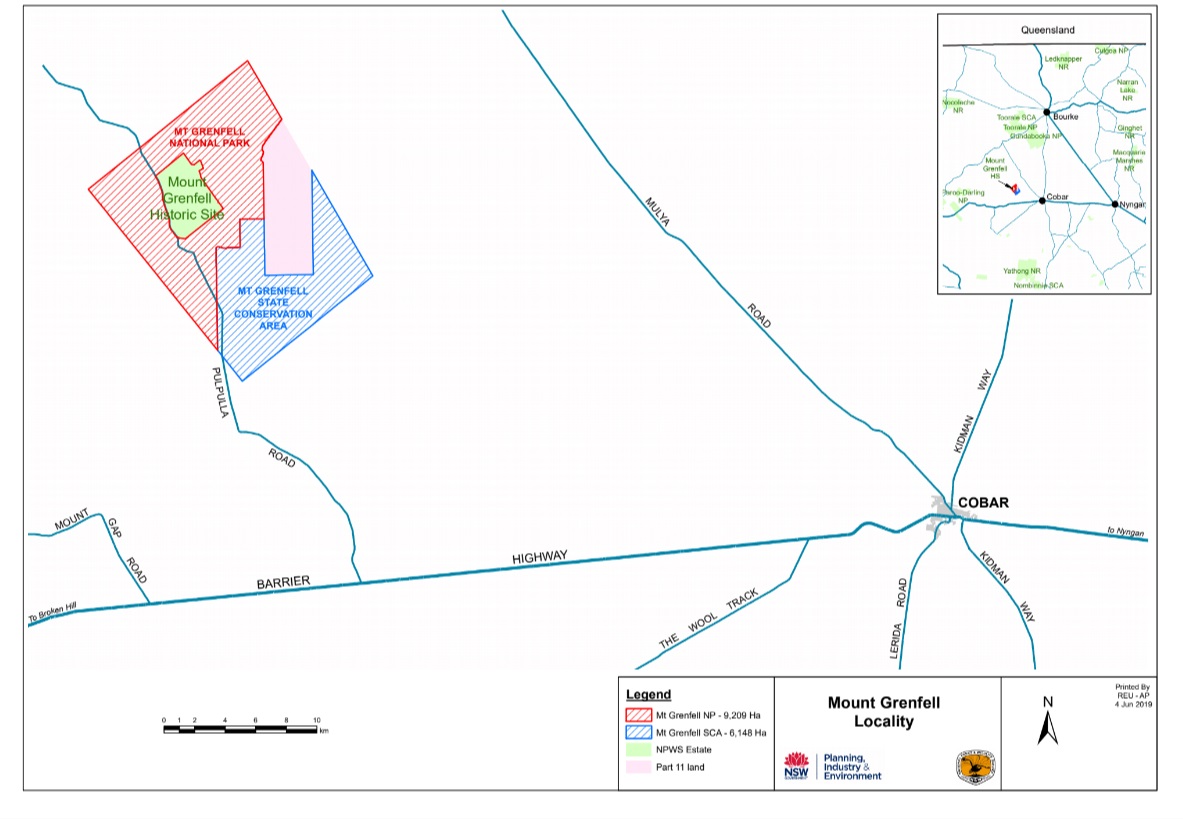
Premier Gladys Berejiklian said these new reservations mean the protected area at Mt Grenfell now covers nearly 17,000 hectares.
“This area is home to the renowned Ngiyampaa rock art galleries and a rich cultural landscape of immense significance to the Aboriginal community,” Ms Berejiklian said.
“Reserving these lands supports Aboriginal owners in maintaining their physical and spiritual connection to Country.“
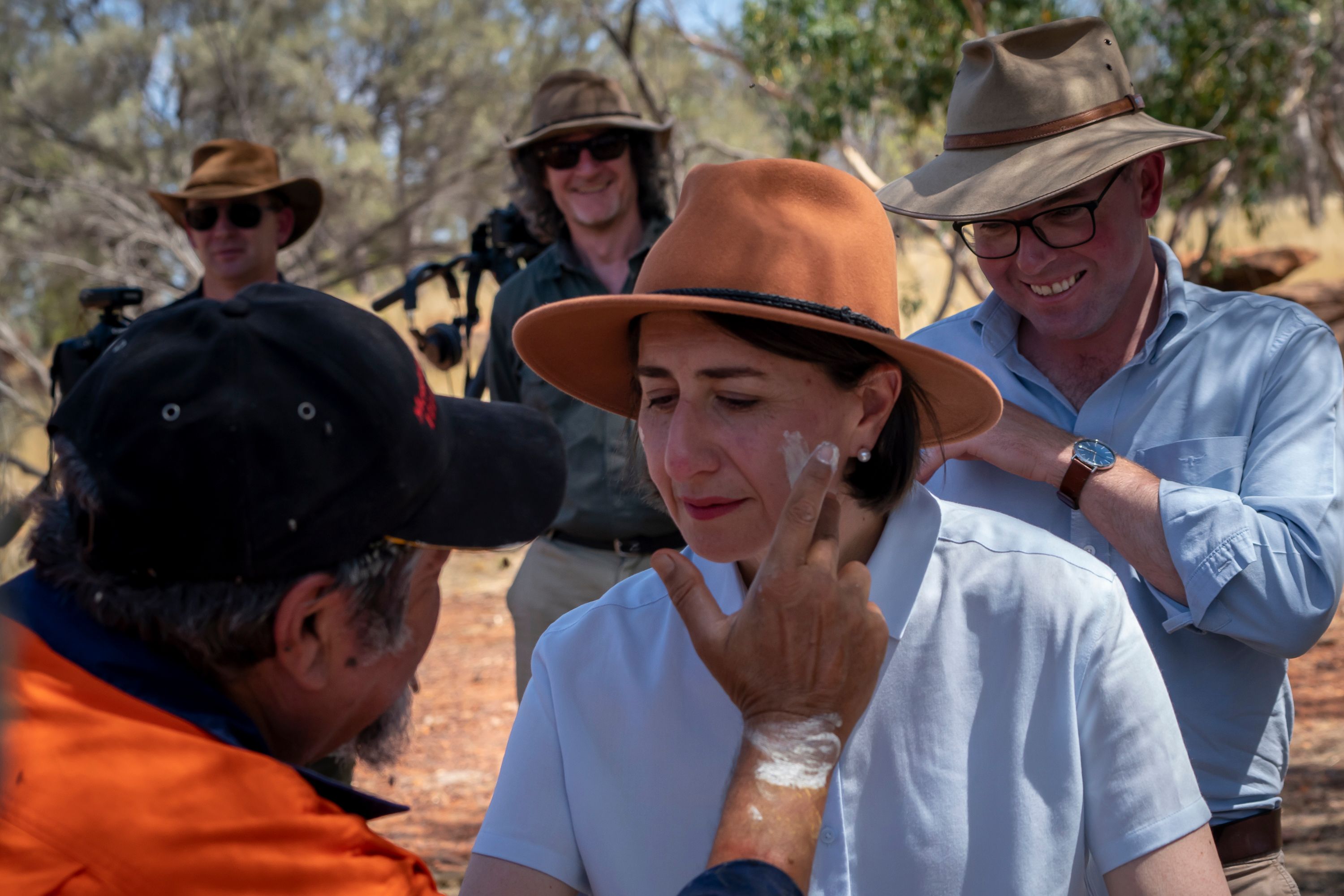
Premier Gladys Berejiklian on site/on country
Environment Minister Matt Kean said the return of these lands to their traditional owners not only has immense cultural significance but an important environmental significance as well.
“These parks are irreplaceable and an important part of our commitment to add 400,000 hectares of national park to our network by the end of 2022,” Mr Kean said.
“The new parks build on existing protections, securing outback ecosystems including habitat for some 130 bird species and 12 threatened species.”
The new park will be Aboriginal-owned land held by Cobar Aboriginal Land Council and co-managed with the Mount Grenfell Board of Management and National Parks and Wildlife Service.
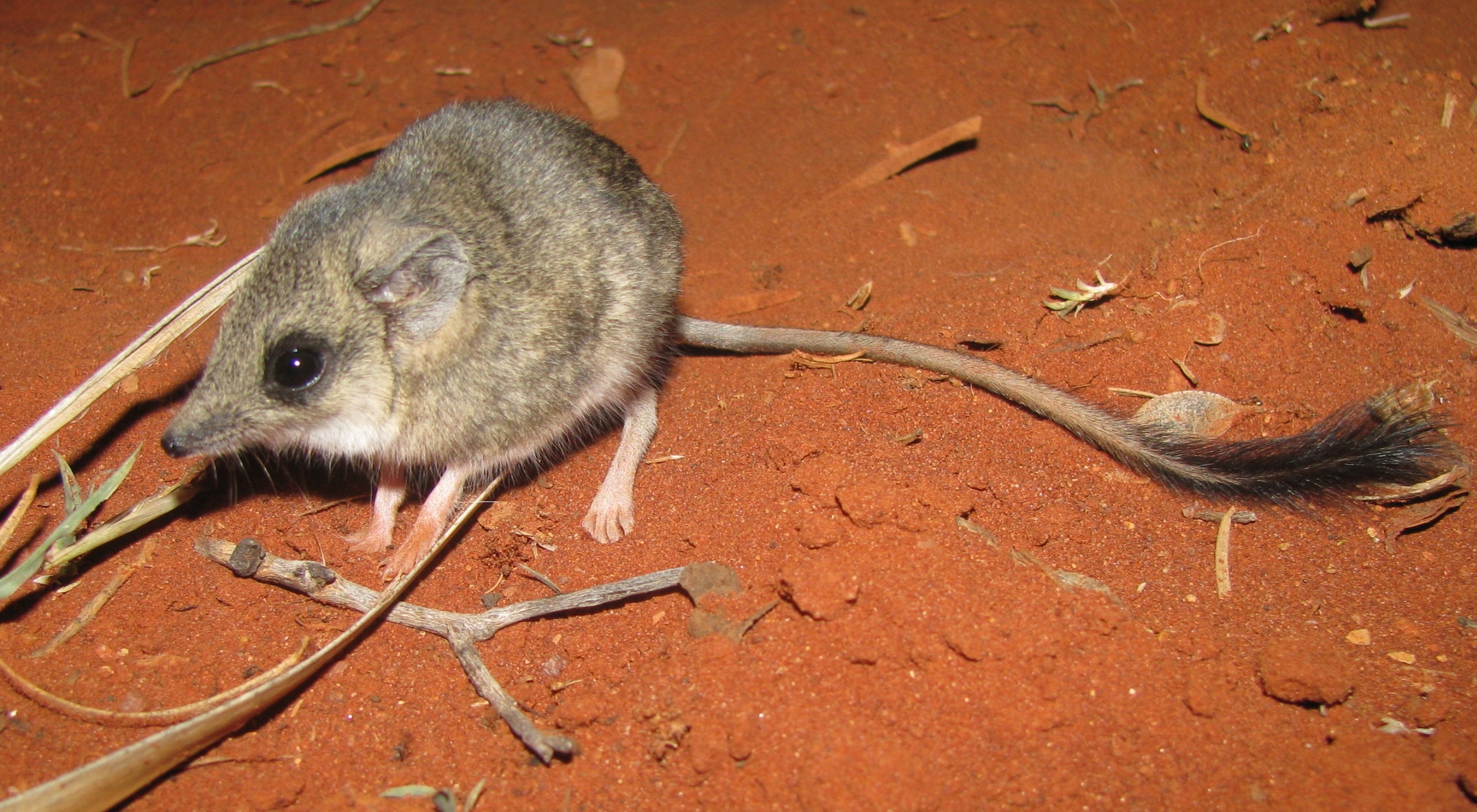
Kultarr. photo credit J. Val DPIE
Key facts
The new Mount Grenfell National Park and adjacent Mount Grenfell State Conservation Area lies about 70 kilometres north-west of Cobar in the dry back Country of the Cobar Peneplain. They surround the Mount Grenfell Historic Site which was handed back to the Ngiyampaa Wangaaypuwan Aboriginal owners in July 2004 and leased back to the NSW Government for management as part of the national parks system.
In recognition of the Aboriginal cultural significance, ownership of these two new reserves is also to be handed over to the Traditional Owners and leased-back to the National Parks and Wildlife Service for co-management with the Mount Grenfell Board of Management.
- Size: Mount Grenfell National Park is 9,189 hectares and Mount Grenfell State Conservation Area is 6,096 hectares.
- Aboriginal heritage: The reserves are an important part of ngurrampaa (Country) for Ngiyampaa Wangaaypuwan. They provide resources which are of importance in people’s lives: spiritually, as a physical connection to Creation stories and Creation beings; culturally, through providing opportunities for cultural practice; and physically, through the provision of food, water, shelter and resources. All these facets of Ngiyampaa Wangaaypuwan life is found in the one location. The reserves are rich in the physical evidence of Ngiyampaa culture including rock art, campsites and hearths associated with a waterhole, quarries, ochre pits, grinding grooves, artefact scatters and scar trees. Many other sites are yet to be discovered.
Bioregional significance: Mount Grenfell National Park and State Conservation Area make a contribution to a comprehensive, adequate and representative reserve system by:
- increasing the level of protection for the Cobar Peneplain bioregion from 2.61% to 2.82%
- Increasing the level of protection for the Barnato Downs subregion from 3.3% to 4.14%.
- protecting one landscape type (Mt Grenfell Ridges) that is currently not represented in any other reserve and another landscape (Barnato Wide Valleys) which is inadequately protected with only 20 hectares sampled in national parks system.
Ecosystems: The reserves:
- increase the protection of eight vegetation communities, including two communities that were not previously sampled in Mount Grenfell Historic site (Belah-Rosewood Open Woodland and River Red Gum - Poplar Box Riparian Woodland).
- support at least 234 native plant species, many of these traditional food and medicine resources for Ngiyampaa Wangaaypuwan. Those used for food include the seeds of a range of plants such as Yaama (kurrajong), Mithirr (miljee), nardoo, Kawanthaa (quandong), Wilkarr (wilga) and Yarrayipipan (rosewood), all of which were ground for flour and baked into johnny cakes.
Threatened species: The reserves provide a range of habitat types with varying structural complexity and floristic diversity which supports 195 bird and animal species. The most diverse groups of animals recorded are bats (13 species) and birds (134 species), including 12 threatened species. These include the kultarr, yellow-bellied sheathtail-bat, little pied bat, inland forest bat, Corbens long-eared bat. Other threatened mammals expected to use this habitat are the stripe-faced dunnart and bristle-faced freetailed-bat.
European heritage: The reserves provide an example of turn-of-the-century pastoral occupation in the Western Division of New South Wales.
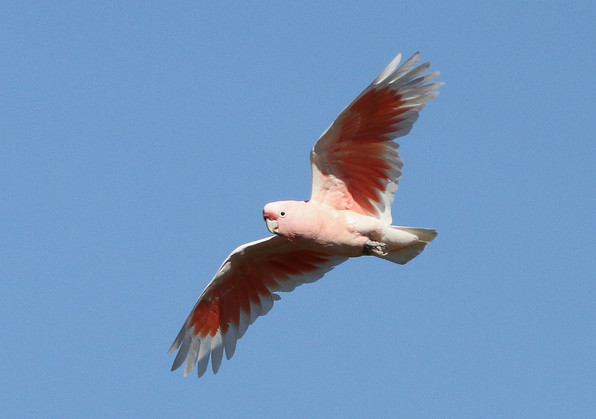
Major Mitchells cockatoo - photo L. Copeland DPIE
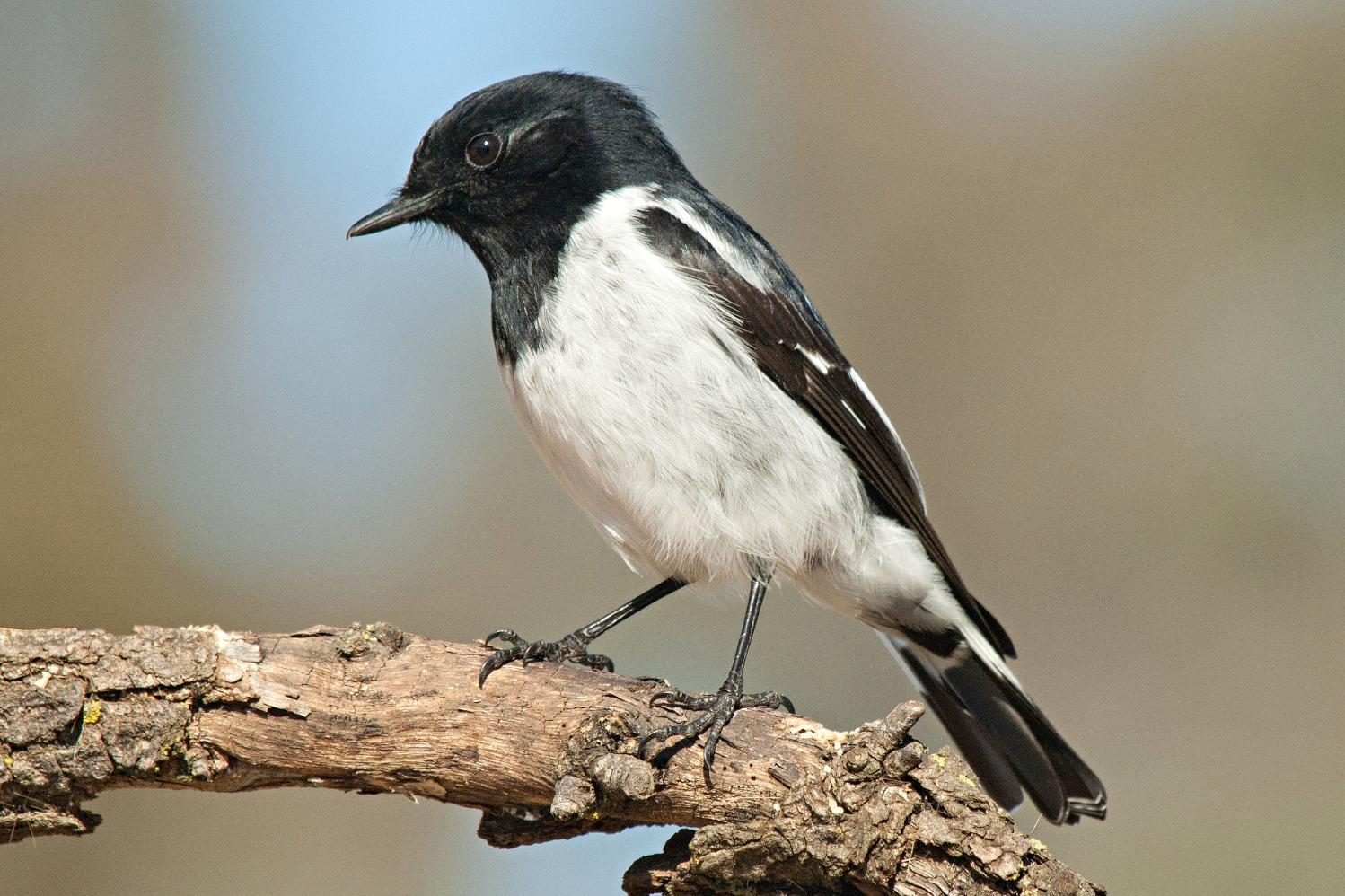
Rare Numbats Reintroduced To NSW National Park
December 3, 2020
The numbat, one of Australia's most unique marsupials and a species rarer than the giant panda, has been reintroduced to a NSW national park for the first time.
NSW Environment Minister Matt Kean said the release of this incredibly rare marsupial into Mallee Cliffs National Park is part of a bold plan to save the species.
"Numbats had almost completely disappeared from NSW by the end of the 19th century and today the only remnant population not protected by predator proof fences are in south-west Western Australia," Mr Kean said.
"With this release we hope this will be a turning point in the right direction for this rare Australian native, and an important step to restoring biodiversity in our national parks."
With an estimated population of just 800 animals remaining, numbats are rarer than black rhinos or giant pandas, at one point their distribution stretched from south-western NSW to south-west Western Australia.
NPWS Deputy Secretary Atticus Fleming said the numbat had suffered a catastrophic decline, driven to the brink of extinction by foxes and feral cats.
"It is only by constructing large feral predator-free areas, using specially designed conservation fences, that species such as numbats can be returned to our parks," Mr Fleming said.
It is expected, with further reintroductions, this population is expected to grow to 270 and re-colonise the landscape, increasing the global populations by over 30%.
The release of numbats into Mallee Cliffs National Park follows the successful reintroduction of bilbies and greater stick nest rats, with further species to be introduced to return the landscape to resemble what it was like before the arrival of feral animals.
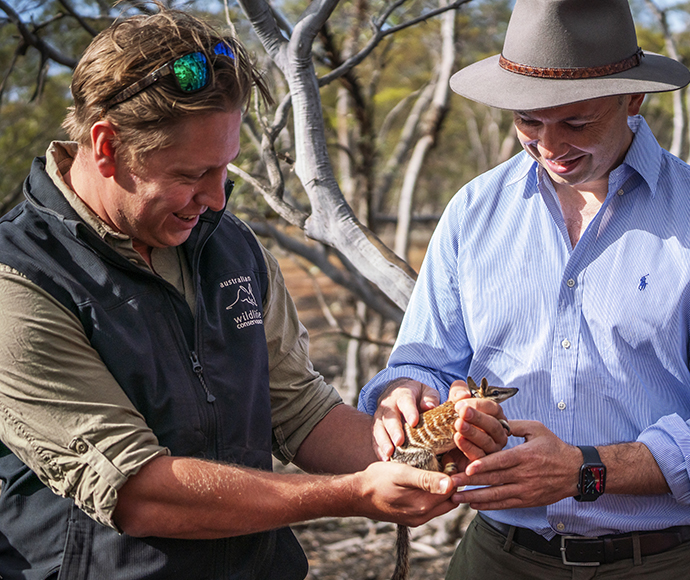
Numbat release (Myrmecobius fasciatus) Mallee Cliffs National Park Credit: DPIE
Volunteers Begin Sweeping Barrington Of 'Scotch Broom' Environmental Weed
December 3, 2020
Local volunteers have lent a helping hand to NSW National Parks and Wildlife Service (NPWS) during a 4-day blitz of environmental weeds in a newly launched program at Barrington Tops National Park.
NPWS and volunteers from the Australian Association of Bush Regenerators, local 4WD clubs and the local community, supported by Hunter Local Land Services, cleared roughly 35,000 square metres of Scotch broom, an invasive environmental weed.
NPWS Area Manager Anthony Signor said the removal of weeds from an area equivalent to almost five soccer fields will drive regeneration of native vegetation in the sub-alpine landscape after last season's significant bushfires.
"This invasive, noxious weed competes with native species and is compromising the post-bushfire recovery of native vegetation on Barrington Tops.
"We are thrilled and grateful for the response of the volunteers for this event. Despite very wet weather, more than 20 volunteers turned up to help us remove the weeds by hand. We couldn't have done it without them" said Mr Signor.
Hunter Local Land Services' Lyndel Wilson said the removal of these invasive weeds will also tip the balance in favour of native animals like the Tooarrana.
"Tooarrana is the Aboriginal name for the vulnerable broad-toothed rat. This chubby-cheeked native animal is restricted to wet alpine and sub-alpine heaths, and woodlands, and is a priority species for bushfire recovery," said Ms Wilson.
"The Tooarrana relies on the shelter of native snow-grass for food, nesting and protection from predators, so it's really important that our agencies work together to combat invasive weeds post-bushfire," said Ms Wilson.
Scotch broom (Cytisus scoparius) was listed as a Weed of National Significance in 2012.
NPWS and Hunter Local Land Services are currently planning more volunteer weeding events in the national park, which will be advertised on the NPWS website.
This project is supported by Hunter Local Land Services through funding from the Australian Government's National Landcare Program and NSW Government's State Bushfire funding.
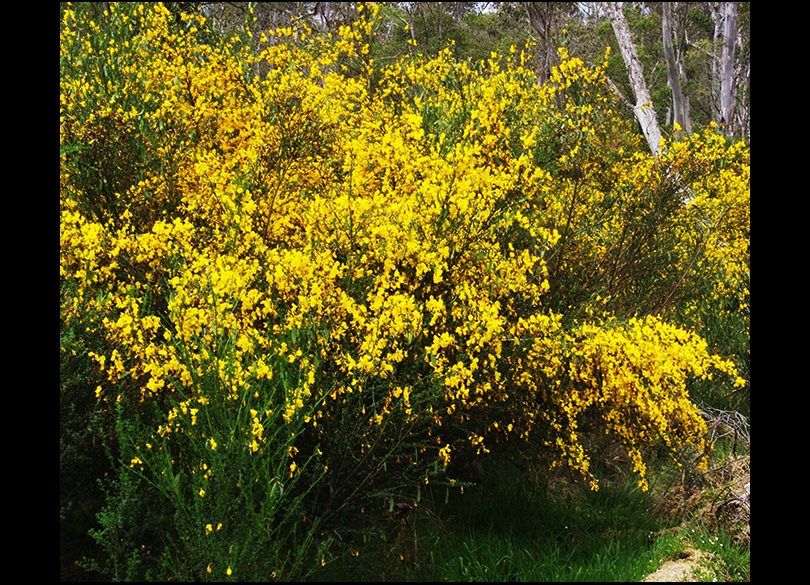
Scotch Broom (Cytisus scoparius subsp. scoparius) Credit: Barry Collier/DPIE
Murray Cod Fishing Season Reopens
Recreational fishers will welcome the first day of summer by being allowed to cast their lines in search of the prized Murray Cod, Minister for Agriculture Adam Marshall has announced.
The season reopens following the annual three-month breeding closure, and Mr Marshall today said there was great Murray Cod fishing to be had in many river systems and impoundments given recent inflows after the drought.
“The Murray Cod is Australia’s largest freshwater fish and an icon of our inland waterways, so this news will be eagerly welcomed by anglers,” Mr Marshall said.
“We have seen recent inflows into our river systems, creating much healthier environments for our native fish species. These are some of the best conditions we have seen in many years.
“During the last three months, the vast majority of anglers have respected the breeding closure period, which shows an appreciation within our community in the importance of protecting our valued populations.
“Now that Murray Cod have completed their breeding, fishing for this prized fish, in line with the general rules, can begin again.”
Mr Marshall reminded anglers that Fisheries Compliance Officers will be out on the water to ensure that legal bag and size limits, and other rules are abided by.
“A daily bag limit of two Murray Cod per person and a total possession limit of four applies when fishing in any inland waters applies,” Mr Marshall said.
“Fishers are also required to release Murray Cod which are smaller than 55cm, or bigger than 75cm, with the least possible harm.
“These rules are in place to ensure sustainable populations into the future, so that our more than one million annual fishers can enjoy their favoured pastime for generations.”
More Murray Cod fishing tips and rules are available on the NSW DPI website.
Information on legal fishing and marine invertebrate collecting is also available through the free FishSmartNSW App.
Anyone with information on suspected illegal fishing activity is urged to contact their local Fisheries office, call the Fishers Watch phone line on 1800 043 536 or report illegal fishing activities online.
Level 1 Water Restrictions Lifted In Greater Sydney
December 1, 2020
From 1 December 2020, Level 1 Water restrictions for Greater Sydney, the Blue Mountains and the Illawarra will be lifted and replaced with Water Wise Guidelines.
Drinking water uses
Under the Water Wise Guidelines, you can use drinking water to:
- water lawns and gardens before 10am and after 4pm using a hand-held hose fitted with a trigger nozzle, sprinklers or standard water systems
- water new turf and gardens at any time for up to 28 days
- water lawns and gardens with drip irrigation systems or smart water systems at any time
- top up pools and spas to replace water lost through evaporation
- fill new or renovated pools and spas
- wash vehicles with a hand-held hose fitted with a trigger nozzle or high-pressure cleaning equipment
- clean buildings (including windows, walls and gutters) with a hand-held hose fitted with a trigger nozzle or high-pressure cleaning equipment
- cool down people or animals.
You will not be able to:
- allow water to run off onto hard surfaces
- leave taps and hoses running unattended
- allow pools or spas to overflow when being filled.
Exemption permits for household and business water use will no longer be required.
Minister for Water Property and Housing Melinda Pavey said people across Greater Sydney have done an outstanding job during water restrictions, collectively saving 77GI of water – the equivalent of 31,000 Olympic-size swimming pools.
"Water restrictions have helped curtail demand by around 65ML each day, taking pressure off the filtration plant to provide clean water from Sydney’s dams which have been impacted by bushfires and heavy rainfall,” Mrs Pavey said.
Find out more about the Water Wise Guidelines
'Unjustifiable': new report shows how the nation's gas expansion puts Australians in harm’s way
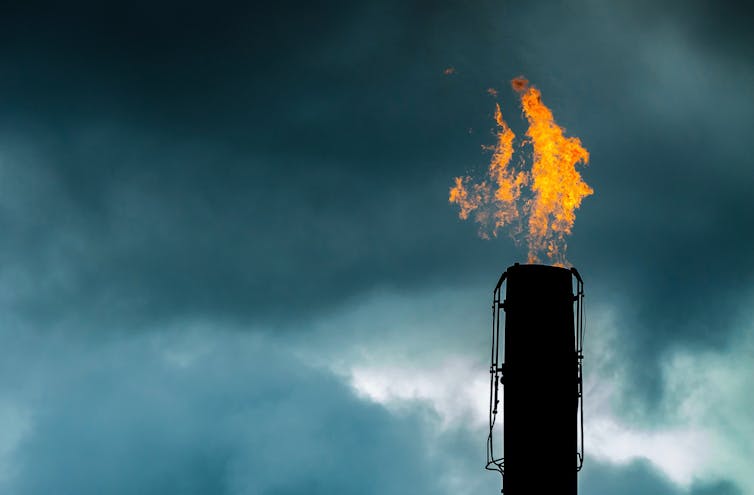
Australia’s latest emissions data, released this week, contained one particularly startling, and unjustifiable, fact. Against all odds, in a year when emissions fell in almost every sector, Australia’s export gas industry still managed to do more climate damage.
A new Climate Council report released today, to which I contributed, sheds more light on the problem of Australia’s expanding gas industry.
It reveals in alarming detail how gas emissions are cancelling out the gains won by Australia’s renewables boom. It also shows how gas emissions are almost certainly under-reported, and uncovers the misleading claims underpinning the Morrison government’s gas-led economic recovery.
This is clearly an unsustainable state of affairs. Australia has this year been in the grip of a climate crisis: unprecedented drought, the Black Summer bushfires and another mass bleaching of the Great Barrier Reef. The gas industry escalates this risk and puts more Australians in harm’s way.
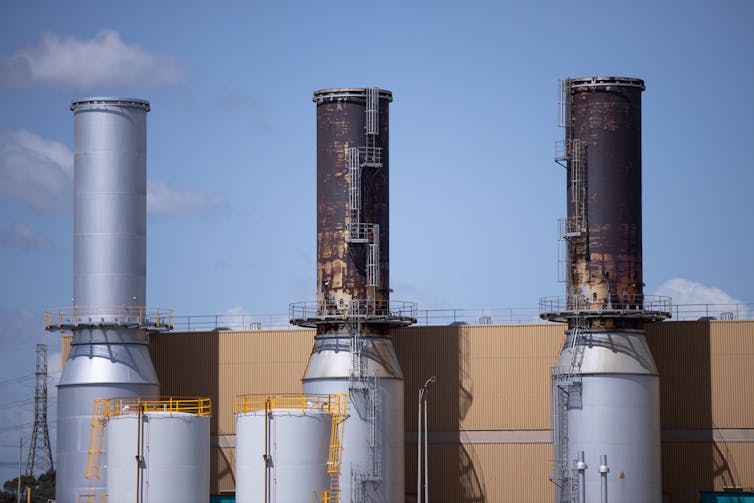
Gas: Bucking The Trend
As is now well known, COVID-19 restrictions helped trigger a fall in carbon dioxide emissions globally.
In Australia, emissions from transport dropped by 24% compared with April–June last year, as people stayed out of cars and planes.
Emissions from electricity dropped by around 5% in the quarter, compared with the corresponding quarter last year. This was mostly due to continued wind and solar expansion; demand for electricity dropped only marginally.
Overall, industrial demand for electricity was roughly the same as last year. Meanwhile, although office blocks and shopping centres were shuttered, power was needed in the domestic sector to heat homes and charge iPads for homeschooling.
Overall, almost every sector, including gas, also produced fewer emissions in the June quarter than in the same period the year before. Across the economy, emissions for the quarter were 7% lower than the same period last year. This result is represented in the graph below.
While emissions from the gas sector declined in the lockdown months, the sector’s poor emissions performance over the full 12 months to June meant it managed to increase its emissions over the year – one of the few sectors to do so.

How Did Gas Get This Bad?
Australia became the world’s largest exporter of liquefied gas in 2019. Our report shows almost three-quarters of gas extracted in Australia in 2019 was compressed and processed to send overseas, as shown below.
Remarkably, on top of this, in 2019 the Australian gas export industry was itself the second-largest user of gas in Australia for the first time. More than a quarter of gas consumed in Australia was used to liquefy and chill gas for export overseas.
So the Australian gas export industry uses or exports nearly 80% of the gas it extracts each year – four times the amount needed to service the country’s own needs. Clearly claims of a shortfall in domestic gas supplies, such as those used to justify the recent Narrabri Gas Project approval, are bogus.
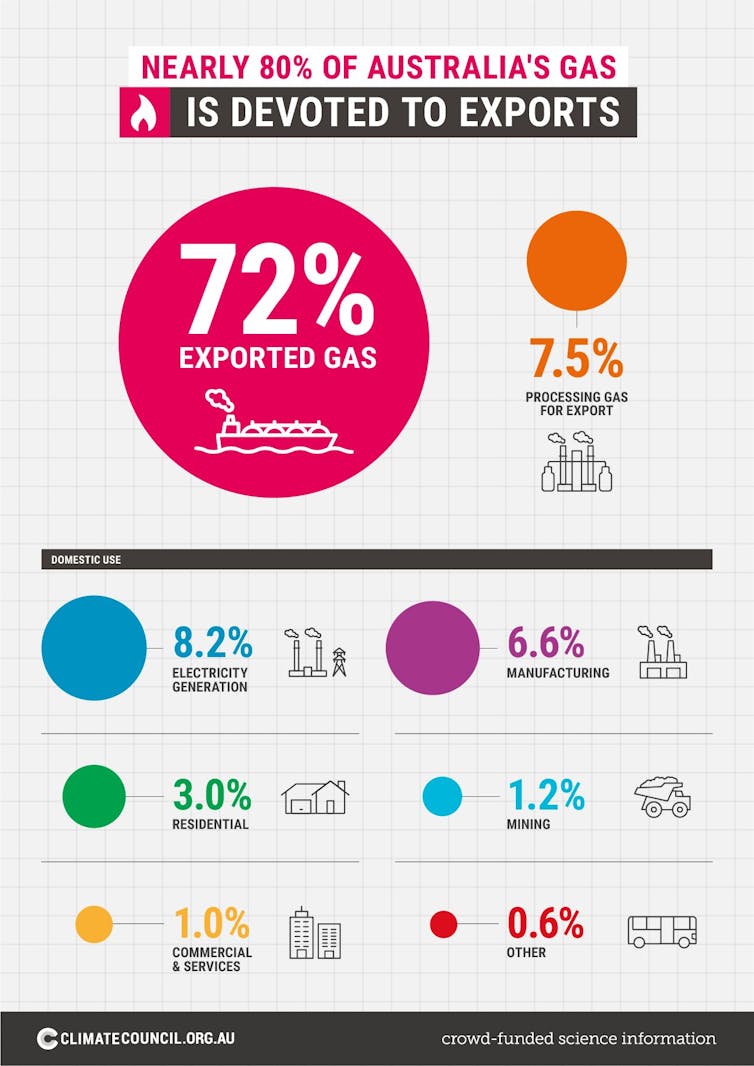
A Worse Problem Than We Thought
The reports shows rising gas emissions are cancelling out gains made by Australia’s record build of solar and wind generation capacity. Between 2005 and 2018, emissions from the electricity sector fell by 15 million tonnes per year. Emissions from the gas sector increased by 25 million tonnes per year in the same period.
Our report also highlights serious problems with official estimates of gas emissions along the supply chain. These estimates are based on decades-old research designed for the US gas industry.
Read more: Climate explained: methane is short-lived in the atmosphere but leaves long-term damage
Australia is also underestimating the harm caused by gas emissions. Methods used by the federal government to quantify the relative impact of methane are incomplete and ignore recent scientific advances. If methane’s effect was considered completely, this would further increase the assessed impact of the gas industry on Australia’s emissions.
Underpinning all this, the international gas market is in crisis as a result of a global oversupply. The drastic increase in Australia’s gas exports in recent years has left us dangerously exposed to international boom-and-bust market cycles, and subsequent job losses and power price volatility.
Most of Australia’s gas is expensive to produce compared to international competitors. The centrepiece of the federal government’s gas-led recovery, a stretch goal of A$4 per gigajoule for gas, has been described by the extraction industry’s own lobbyists as a “myth”. And several Australian export plants were recently declared by banking giant HSBC as “at risk”.
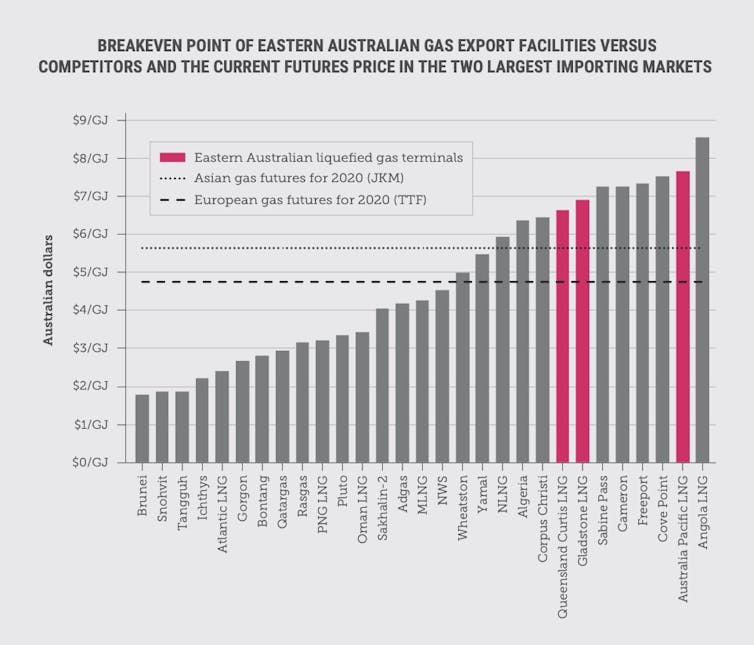
Seizing The Opportunity
Fossil fuel extraction and consumption in Australia makes up 80% of our annual emissions. But as the Climate Council report shows, this figure is likely a gross underestimate. And of course, it does not account for the additional emissions produced when Australia’s gas exports are burned overseas.
COVID created a temporary blip in global emissions. If we don’t use it as an opportunity to consider a planet without coal, oil and gas consumption, the climate gains will amount to nothing.![]()
Tim Baxter, Fellow - Melbourne Law School; Senior Researcher - Climate Council; Associate - Australian-German Climate and Energy College, University of Melbourne
This article is republished from The Conversation under a Creative Commons license. Read the original article.
Victoria just gave 2 billion litres of water back to Indigenous people. Here's what that means for the rest of Australia
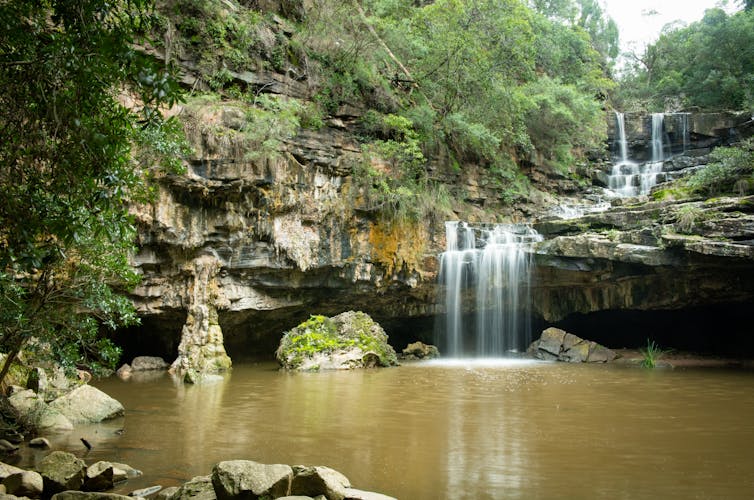
For the first time in Victoria’s history, the state government has handed back water to traditional owners, giving them rights to a river system they have managed sustainably for thousands of years.
The two billion litres of water returned to the Gunaikurnai Land and Waters Aboriginal Corporation (GLaWAC) this month means traditional owners can now determine how and where water is used for cultural, environmental or economic purposes.
The decision recognises that water rights are crucial for Indigenous people to restore customs, protect their culture, become economically independent and heal Country.
The hand-back to Gunaikurnai people is the crucial first step in a bigger, statewide process of recognising Indigenous people’s deep connection to water. It also serves as an example to the rest of Australia, where Indigenous rights to water are grossly inadequate.
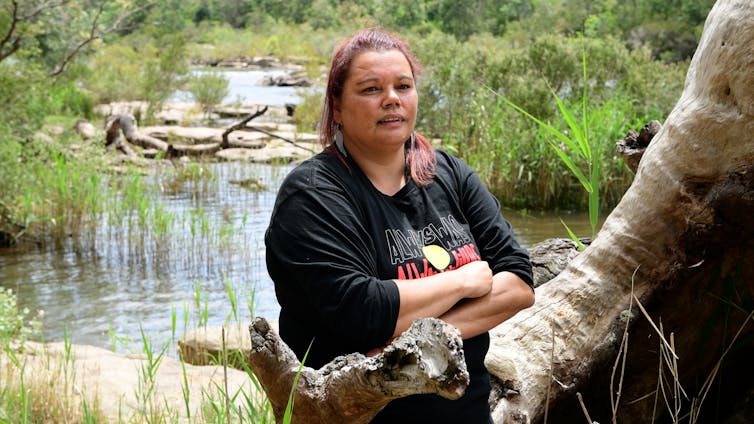
Water’s Rightful Home
Gunaikurnai people hold native title over much of Gippsland, from the mountains to the sea.
The water hand-back comes ten years since this native title was secured, and since Gunaikurnai people entered into the state’s first Traditional Owner Settlement Agreement with the government. Under this agreement, GLaWAC is a joint manager, with Parks Victoria, of ten parks and reserves in Gippsland, including the Mitchell River National Park.
Victorian water minister Lisa Neville said the hand-back was a key milestone in her government’s 2016 Aboriginal Water Policy. That plan aims to:
- recognise Aboriginal values and objectives of water
- include Aboriginal values and traditional ecological knowledge in water planning
- support Aboriginal access to water for economic development
- build capacity to increase Aboriginal participation in water management.
GLaWAC engages closely with government agencies that control how water is shared and used and these partnerships are highly valued. But it is only through owning water that traditional owners can really control how water is used to care for Country and for people.
For the moment, the water will be staying in the river. Its use will be decided after discussions between GLaWAC and Gunaikurnai community members.
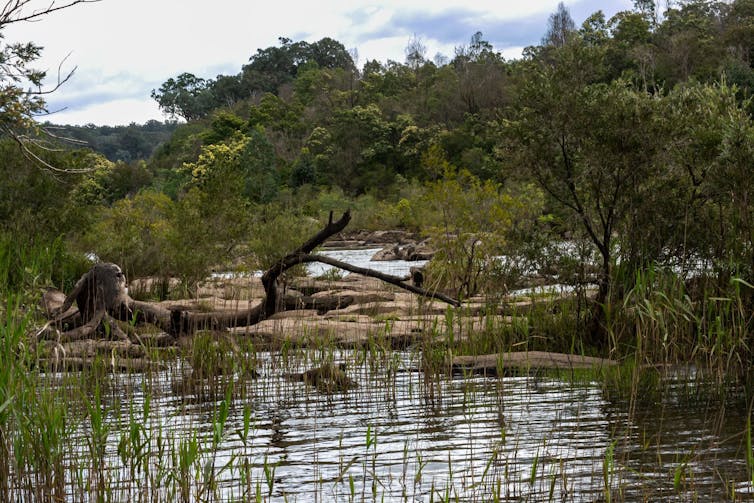
Barriers To Water Ownership
In 2016, the Victorian government committed A$5 million to a plan to increase Aboriginal access to water rights, including funding for traditional owners to develop feasibility plans to support water-based businesses.
There are significant barriers to reallocating water to Victoria’s traditional owners. Water is expensive to buy, hold and use. Annual fees and charges can easily run to tens of thousands of dollars a year in some locations.
Using water to care for Country supports well-being, the environment and other water uses, including tourism and recreation. But, unlike using water for irrigation, there may not be any direct economic return from a water hand-back. This means water recovery for traditional owners must include ways to cover fees and charges.
Read more: Australia has an ugly legacy of denying water rights to Aboriginal people. Not much has changed
Victoria’s water entitlement framework is also consumption-based – it is designed for water to be taken out of rivers, not left in. This can make it hard for traditional owners to leave water in the river for the benefit of the environment. So water entitlements and rules should be changed to reflect how traditional owners want to manage water.
Lastly, many traditional owners lack access to land where they can use the water. Or they may wish to use water in areas that, under natural conditions, would be watered when rivers flood, but which are now disconnected from the waterway. To help overcome this, traditional owners should be given access to Crown land, including joint management of parks. GLaWAC’s partnership agreements are a good example of how this might happen in future.
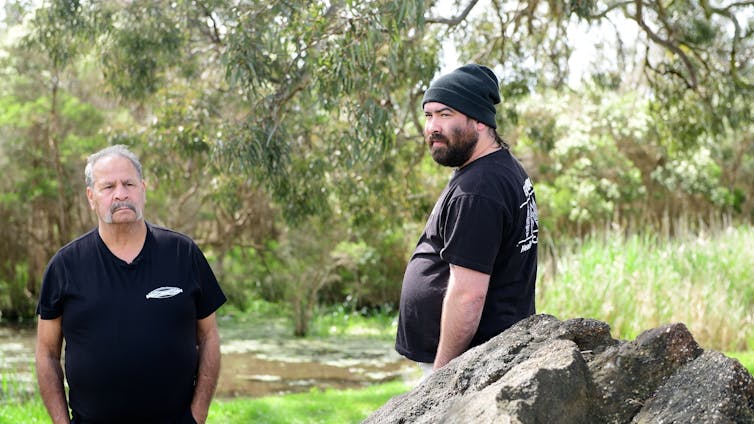
Change Is Possible
While significant barriers to water access remain, this hand-back shows how real water outcomes for traditional owners can be achieved when there is political will and ministerial support.
The water is part of six billion litres on the Mitchell River identified as unallocated, meaning no-one yet has rights over it. The remaining four billion litres will be made available on the open market, for use by irrigators or other industries. It can be extracted only during the colder months from July 1 to October 31.
The extraction and use of the water by Gunaikurnai people will be linked to specific locations, and the licence is up for renewal every 15 years. GLaWAC will work with state agency Southern Rural Water to ensure that the licence conditions match the water plans of traditional owners.
This step is crucial. There have been many instances in other states where traditional owners have obtained water, but been unable to use it due to barriers on how it can be used, and annual fees and charges.
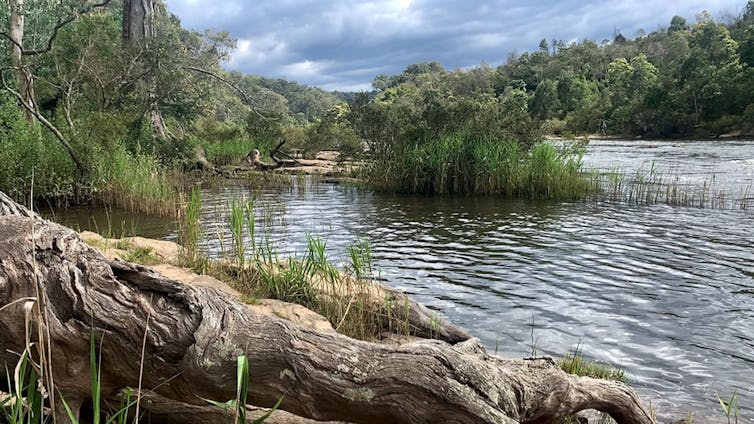
Overcoming A History Of Injustice
Traditional owners across Australia never ceded their rights to water. Yet Aboriginal people own less than 1% of the nation’s water rights. Righting this wrong is the “unfinished business” of national water reform.
Even when political commitments are made, there has been little progress. For example, in 2018 the federal government committed A$40 million to acquire water rights for Aboriginal people in the Murray-Darling Basin, but no purchase of water rights has yet occurred.
This woeful and unjust situation is also reflected in Victoria. Before the Gunaikurnai hand-back, only a tiny handful of Aboriginal-owned organisations and one traditional owner, Taungurung, owned water rights in Victoria, and the volumes were small. In these cases, water recovery was not a formal hand-back from the state, and included a donation from a farmer.
Across Australia, Aboriginal people are watching the Victorian water reform process with great interest. The water returned to Gunaikurnai people builds momentum, and increases pressure on governments across Australia to take water justice seriously.
Read more: Aboriginal voices are missing from the Murray-Darling Basin crisis ![]()
Troy McDonald, Chairman of Gunaikurnai Land and Waters Aboriginal Corporation, Indigenous Knowledge and Erin O'Donnell, Early Career Academic Fellow, Centre for Resources, Energy and Environment Law, University of Melbourne
This article is republished from The Conversation under a Creative Commons license. Read the original article.
'Severely threatened and deteriorating': global authority on nature lists the Great Barrier Reef as critical
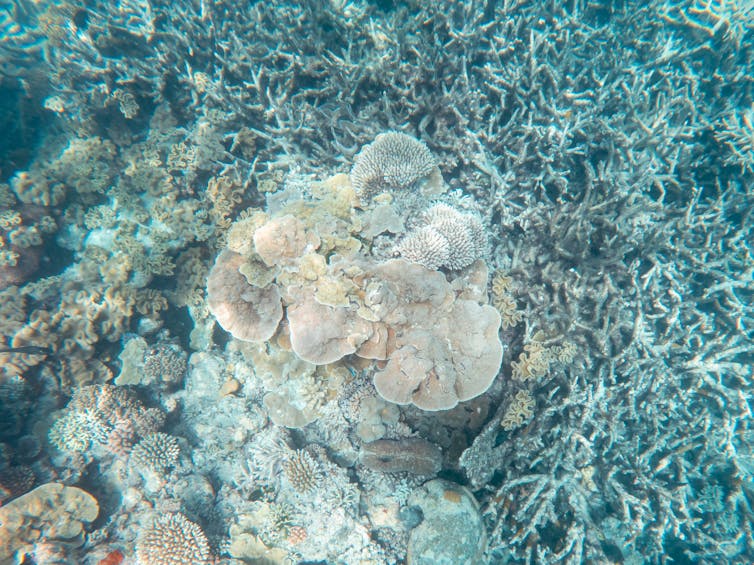
The Great Barrier Reef is now in “critical” condition and the health of four other Australian World Heritage properties has worsened, according to a sobering report just released by the International Union for Conservation of Nature (IUCN).
The IUCN is the global authority on nature. Its third outlook report marks the first time the IUCN has declared an Australian property as critical, which means its values are severely threatened and deteriorating. The health of the Blue Mountains, Gondwana Rainforests, Shark Bay and the Ningaloo Coast has also been downgraded.
Read more: We just spent two weeks surveying the Great Barrier Reef. What we saw was an utter tragedy
The assessment, while chastening, is not surprising. The Great Barrier Reef has endured three mass coral bleaching events in five years, and last summer’s bushfires caused untold damage in the Blue Mountains and Gondwana Rainforests (not to mention the current fires at the reef’s Fraser Island).
Climate change remains the key issue for World Heritage places, not just in Australia but globally. In fact, the IUCN assessment found climate change threatens 11 of Australia’s 16 properties. This raises further questions over our national climate response.
World Heritage: The Best Of The Best
The latest report builds on previous reports from 2014 and 2017, and shows the status and trends of World Heritage properties identified for their outstanding natural values. As the report states:
our ability to conserve these sites is thus a litmus test for the broader success of conservation worldwide.
To qualify for World Heritage listing for natural values, a place must meet one or more of four criteria: exceptional beauty, geology, ecological processes, and species and habitats.
Some properties are also recognised for cultural values and, if they have both, they’re referred to as “mixed”. Across the world there are 252 natural and mixed World Heritage properties, of which 16 are in Australia.
The IUCN is the official advisor on nature to UNESCO’s World Heritage Committee. The IUCN Outlook report involves assessments by hundreds of international experts, who examine the conservation prospects of all natural and mixed World Heritage properties. It focuses on their natural values, the threats to these values and the effectiveness of actions to protect them.
Threats To Our Iconic Places
Climate change is now the most prevalent threat to natural World Heritage sites, and to many cultural sites.
Overall, the report assessed climate change as a high or a very high threat in 83 out of 252 global properties (33%). This rate is double in Australia, with climate change listed as a threat to 69% (11 of 16) of Australian properties.
And when considering the four natural criteria individually, climate change is the greatest threat to each. This is likely to get worse in future, as climate change is expected to affect more than three times the number of properties impacted by any other threat.
For many properties, the deteriorated conservation outlook is the result of accumulated threats. Impacts of climate change, like coral bleaching and bushfires, are often exacerbated by other threats. For example, the federal government’s 2019 Outlook Report for the Great Barrier Reef listed 45 threats including climate change. This included poor water quality from land-based runoff, coastal development and fishing.
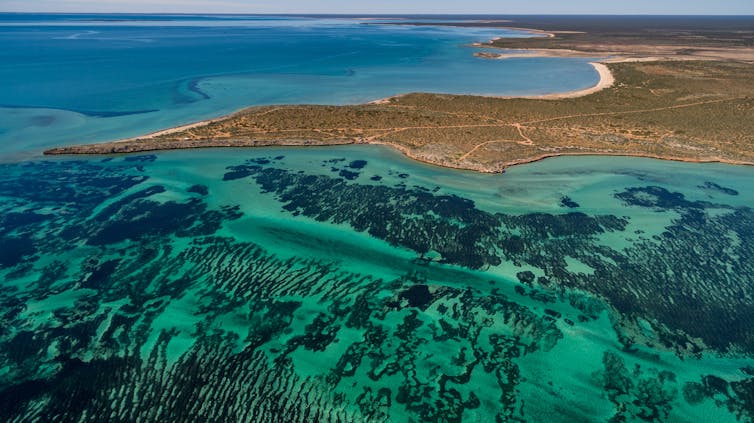
At the time of writing, the website which provides the full rationale behind the IUCN outlook was not yet publicly available. However the threats facing the five downgraded Australian sites are well documented.
These include marine heatwaves, which lead to coral bleaching in the Great Barrier Reef and Ningaloo. In Shark Bay, marine heatwaves also cause seagrass — critical habitat for a vast diversity of species — to die-off. Poor water quality, such as from urban and agricultural run-off, is another big threat to the Great Barrier Reef.
Read more: ‘Bright white skeletons’: some Western Australian reefs have the lowest coral cover on record
More frequent and intense bushfires are a problem for the Blue Mountains, Shark Bay, and Gondwana Rainforests. These ancient rainforests, along with Ningaloo and Shark Bay, also face threats of invasive species, diseases and storms.
Punching Below Our Weight
While there have been some successes globally, the threats facing our heritage places are escalating.
Since the 2017 assessment, of the 252 properties analysed globally, 16 (6%) have deteriorated and only eight (3%) showed improvement. Notably, Australia is punching below its weight, with 31% of properties having deteriorated (5 of 16) and zero with improvement.
Read more: Prepare for hotter days, says the State of the Climate 2020 report for Australia
All of Australia’s World Heritage properties are recognised as having “highly effective” or “mostly effective” protection and management activities.
But the deterioration of the Great Barrier Reef, the Blue Mountains, Gondwana Rainforests, Shark Bay and Ningaloo Coast casts doubt on whether these actions are an effective response to threats, especially climate change.
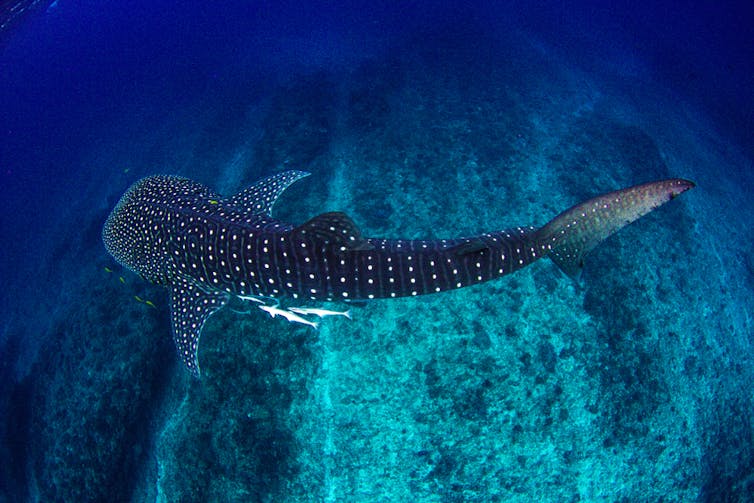
Australia’s climate response has been widely criticised, most recently by Christiana Figueres, the former chief of the UN Climate Framework. In a keynote to open the Australian Emissions Reductions Summit yesterday, Figueres said:
I have been pretty vocal about my frustration for so many years of the completely unstable, volatile, unpredictable stand and position on climate change in Australia.
“Meeting and beating” Australia’s 2030 emissions targets has been the Morrison government’s catch-cry. But the target lacks ambition and the government hasn’t ruled out using Kyoto carry-over credits to help meet it. The government has also refused to commit to a target of net-zero emissions by mid century, in contrast to the policies of many of our international peers.
Management of non-climate stressors is, and will remain, essential to halt the decline of the values of our properties. But Australia must adopt more ambitious climate goals to avoid losing those values that make our heritage places special, preserving them for future generations.
Jon C. Day, PSM, Post-career PhD candidate, ARC Centre of Excellence for Coral Reef Studies, James Cook University and Scott F. Heron, Associate professor, James Cook University
This article is republished from The Conversation under a Creative Commons license. Read the original article.
Climate change is resulting in profound, immediate and worsening health impacts, over 120 researchers say
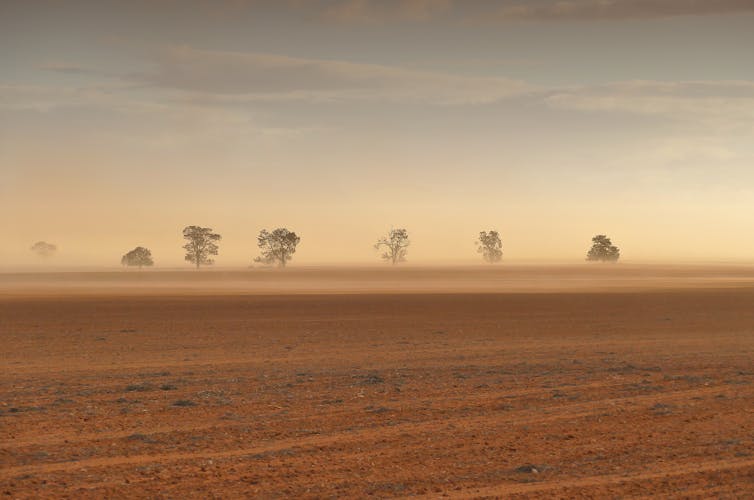
Climate change is resulting in profound, immediate and worsening health impacts, and no country is immune, a major new report from more than 120 researchers has declared.
This year’s annual report of The Lancet Countdown on Health and Climate Change, released today, presents the latest data on health impacts from a changing climate.
Among its results, the report found there were 296,000 heat-related premature deaths in people over 65 years in 2018 (a 54% increase in the last two decades), and that global yield potential for major crops declined by 1.8–5.6% between 1981 and 2019.
We are part of the Lancet Countdown sub-working group focusing on human migration in a warming world. We estimate that, based on current population data, 145 million people face potential inundation with global mean sea-level rise of one metre. This jumps to 565 million people with a five metre sea-level rise.
Read more: Coronavirus is a wake-up call: our war with the environment is leading to pandemics
Unless urgent action is taken, the health consequences of climate change will worsen. A globally coordinated effort tackling COVID-19 and climate change in unison is vital, and will mean a triple win: better public health, a more sustainable economy and environmental protection.
Drought, Fires And Excessive Heat
The 2020 report brings together research from a range of fields, including climate science, geography, economics and public health. It focuses on 43 global indicators, such as altered geographic spread of infectious disease, health benefits of low-carbon diets, net carbon pricing, climate migration and heat-related deaths.
The five hottest years on record have occurred since 2015, and 2020 is on track to be the first or second hottest year on record.
The 2020 Lancet Countdown report found extreme heat continues to rise in every region in the world and particularly affects the elderly, especially those in Japan, northern India, eastern China and central Europe. It is also a big problem for those with pre-existing health conditions and outdoor workers in the agricultural and construction sectors.
Read more: The world endured 2 extra heatwave days per decade since 1950 – but the worst is yet to come
While attributing heat-related deaths to climate change isn’t straightforward, rising temperatures and humidity will mean we can expect heat-related deaths to increase further.
Climate change is also an important contributing factor to drought. The report found that in 2019 excess drought affected over twice the global land surface area, compared with the 1950-2005 baseline.
Drought and health are intertwined. Drought can cause dwindling drinking water supplies, reduced livestock and crop productivity, and an increased risk of bushfire.
Mental health is also at risk, as Australian research from earlier this year confirmed. This looked at the declining mental health of drought-affected farmers in the Murray-Darling Basin over 14 years.

Further, the Lancet Countdown report found that between 2015 and 2019, the number of people exposed to bushfires increased in 128 countries, compared with a 2001-2004 baseline.
Read more: Climate change is bringing a new world of bushfires
Climate change worsens risk factors for more frequent and intense bushfires. We need only look to last summer’s unprecedented bushfires in Australia as a stark illustration. The number of people exposed to the bushfires was amplified by expanding settlements and inadequate risk reduction measures.
Sea Level Rise, Human Migration And Health
As the world warms and the sea rises, millions of people will be exposed to coastal changes, including inundation and erosion.
Sea-level rise has direct and indirect consequences for human health. In some places, water and soil quality and supply will be compromised due to the intrusion of saltwater. Flooding and wave power will damage infrastructure, including drinking water and sanitation services. And disease vector ecology will also change, such as higher mosquito densities in coastal habitats, potentially causing greater transmission of infectious diseases like dengue or malaria.
However, people and communities may adapt by moving away. In Fiji, for example, at least four communities have relocated in response to coastal changes. The Fijian government notes planned relocation will be a last resort only when other adaptation options are exhausted.
Relocation might also lead to health threats . This includes physical health consequences from altered diets, as fishing and subsistence agriculture may be disrupted. There are also mental health impacts from people losing their attachments and connections to their places of belonging.
But sometimes, migration responses to climate change can have health benefits. Moving from vulnerable coastlines might reduce exposure to environmental hazards such as flooding, be an impetus to seek healthier livelihoods and lifestyles, and improve access to health services.
Our estimation of the number of people facing potential inundation is based on projections of global mean sea-level rise and on current population data.
In a high emissions scenario with warming of 4.5℃, seas could rise by one metre by 2100 relative to 1986–2005. This would see 145 million people face potential inundation.
A collapse of the Western Antarctic Ice Sheet could cause five to six metres of sea level rise. Under this extreme scenario, 565 million people may be inundated.
Read more: How many people will migrate due to rising sea levels? Our best guesses aren't good enough
It is important to note, however, that uncertainties constrain our ability to forecast migration numbers due to sea-level rise. These uncertainties include future environmental and demographic factors and potential adaptation (and maladaptation) responses, such as living with water or coastal fortification.
So Is There Any Good News?
The 2020 Lancet Countdown report notes improvements in some instances, as some sectors and countries take bold steps to respond to climate change.
We are seeing, for example, health benefits emerging from the transition to clean energy. Deaths from air pollution attributed to coal-fired power have declined from 440,000 in 2015 to 400,000 in 2018, despite overall population increases.
But more must be done: we need sustained greenhouse gas emission cuts, increased greenhouse gas absorption and proactive adaptation actions. Yet global efforts to address climate change still fall short of the commitments made in the Paris Agreement five years ago.
We cannot afford to focus attention on the COVID-19 pandemic at the expense of climate action.
If responses to the economic impacts of COVID-19 align with an effective response to climate change, we’ll see immense benefits for human health, with cleaner air, healthier diets and more liveable cities.![]()
Celia McMichael, Senior Lecturer in Geography, University of Melbourne; Ilan Kelman, Professor of Disasters and Health, UCL; Shouro Dasgupta, Lecturer in Environmental Economics, Università Ca'Foscari, and Sonja Ayeb-Karlsson, Senior Researcher, Institute for Environment and Human Security (UNU-EHS), United Nations University
This article is republished from The Conversation under a Creative Commons license. Read the original article.
Tick Population Booming In Our Area
Residents from Terrey Hills and Belrose to Narrabeen and Palm Beach report a high number of ticks are still present in the landscape. Local Veterinarians are stating there has not been the usual break from ticks so far and each day they’re still getting cases, especially in treating family dogs.
To help protect yourself and your family, you should:
- Use a chemical repellent with DEET, permethrin or picaridin.
- Wear light-colored protective clothing.
- Tuck pant legs into socks.
- Avoid tick-infested areas.
- Check yourself, your children, and your pets daily for ticks and carefully remove any ticks using a freezing agent.
- If you have a reaction, contact your GP for advice.
 Shorebird Identification Booklet
Shorebird Identification Booklet
The Migratory Shorebird Program has just released the third edition of its hugely popular Shorebird Identification Booklet. The team has thoroughly revised and updated this pocket-sized companion for all shorebird counters and interested birders, with lots of useful information on our most common shorebirds, key identification features, sighting distribution maps and short articles on some of BirdLife’s shorebird activities.
The booklet can be downloaded here in PDF file format: http://www.birdlife.org.au/documents/Shorebird_ID_Booklet_V3.pdf
Paper copies can be ordered as well, see http://www.birdlife.org.au/projects/shorebirds-2020/counter-resources for details.
Download BirdLife Australia's children’s education kit to help them learn more about our wading birdlife
Shorebirds are a group of wading birds that can be found feeding on swamps, tidal mudflats, estuaries, beaches and open country. For many people, shorebirds are just those brown birds feeding a long way out on the mud but they are actually a remarkably diverse collection of birds including stilts, sandpipers, snipe, curlews, godwits, plovers and oystercatchers. Each species is superbly adapted to suit its preferred habitat. The Red-necked Stint is as small as a sparrow, with relatively short legs and bill that it pecks food from the surface of the mud with, whereas the Eastern Curlew is over two feet long with a exceptionally long legs and a massively curved beak that it thrusts deep down into the mud to pull out crabs, worms and other creatures hidden below the surface.
Some shorebirds are fairly drab in plumage, especially when they are visiting Australia in their non-breeding season, but when they migrate to their Arctic nesting grounds, they develop a vibrant flush of bright colours to attract a mate. We have 37 types of shorebirds that annually migrate to Australia on some of the most lengthy and arduous journeys in the animal kingdom, but there are also 18 shorebirds that call Australia home all year round.
What all our shorebirds have in common—be they large or small, seasoned traveller or homebody, brightly coloured or in muted tones—is that each species needs adequate safe areas where they can successfully feed and breed.
The National Shorebird Monitoring Program is managed and supported by BirdLife Australia.
This project is supported by Glenelg Hopkins Catchment Management Authority and Hunter Local Land Services through funding from the Australian Government’s National Landcare Program. Funding from Helen Macpherson Smith Trust and Port Phillip Bay Fund is acknowledged.
The National Shorebird Monitoring Program is made possible with the help of over 1,600 volunteers working in coastal and inland habitats all over Australia.
The National Shorebird Monitoring program (started as the Shorebirds 2020 project initiated to re-invigorate monitoring around Australia) is raising awareness of how incredible shorebirds are, and actively engaging the community to participate in gathering information needed to conserve shorebirds.
In the short term, the destruction of tidal ecosystems will need to be stopped, and our program is designed to strengthen the case for protecting these important habitats.
In the long term, there will be a need to mitigate against the likely effects of climate change on a species that travels across the entire range of latitudes where impacts are likely.
The identification and protection of critical areas for shorebirds will need to continue in order to guard against the potential threats associated with habitats in close proximity to nearly half the human population.
Here in Australia, the place where these birds grow up and spend most of their lives, continued monitoring is necessary to inform the best management practice to maintain shorebird populations.
BirdLife Australia believe that we can help secure a brighter future for these remarkable birds by educating stakeholders, gathering information on how and why shorebird populations are changing, and working to grow the community of people who care about shorebirds.
To find out more visit: http://www.birdlife.org.au/projects/shorebirds-2020/shorebirds-2020-program
Pittwater Reserves
Aussie Bread Tags Collection Points

Ecojoey Video
Published December 2nd, 2020 by Barrenjoey High School
Drowning Schoolie Saved In Brave Rescue By NASA Member- Avalon Beach SLSC Bronze Holder
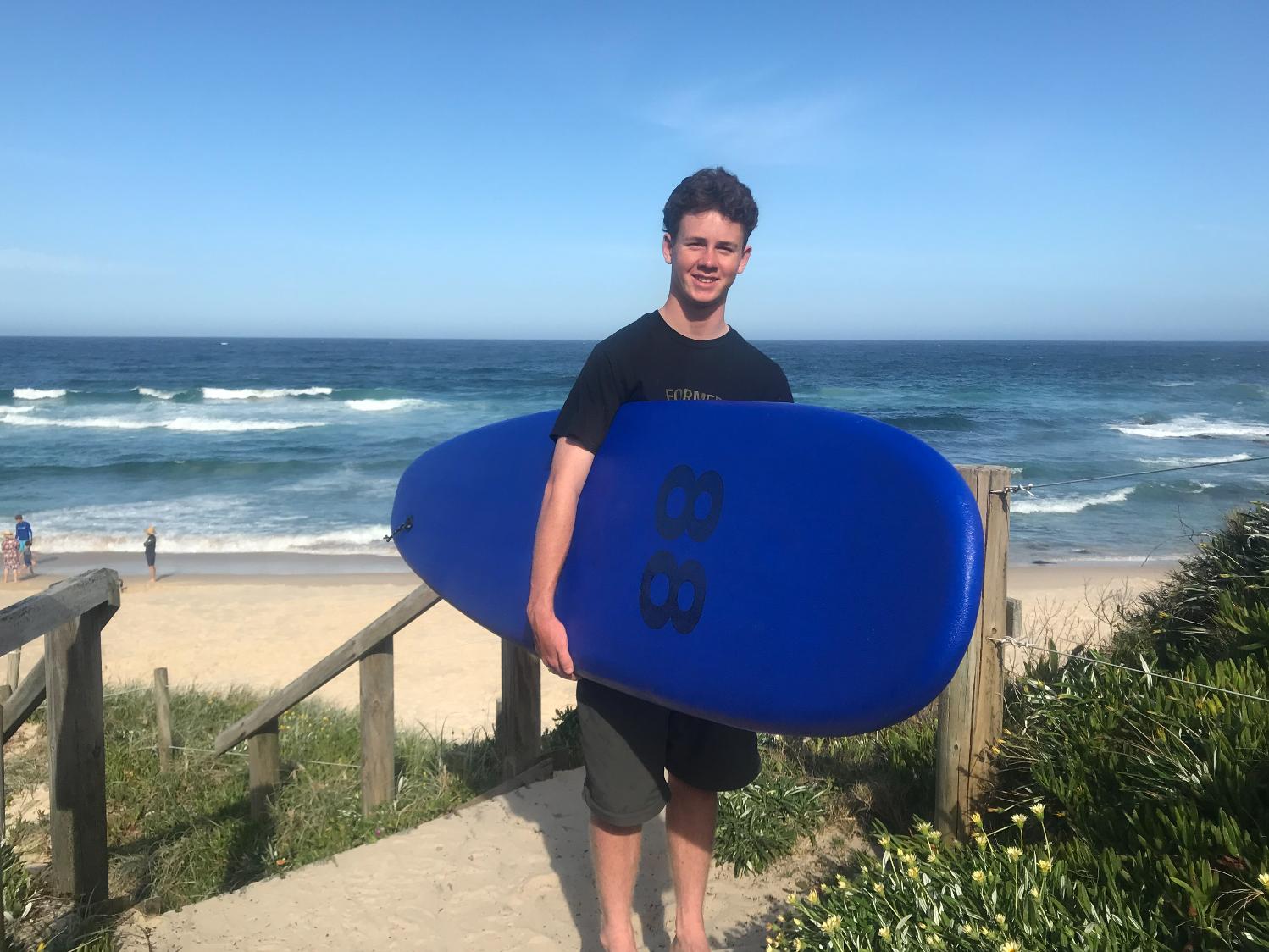
“I didn’t think anyone was coming.”
Lachlan Arnold says it chills him to the bone to recall those words, spoken by the teenage girl lying on the beach waiting for the Ambulance to arrive.
Luckily for the young schoolie from Taree, Lachlan and his son Max happened to be on the unpatrolled Boomerang Beach that day and had the courage and the skills to save her life, reaching the drowning girl with just seconds to spare.
Max Arnold is just 16 years-old but has been involved with his local surf club since he was a six-year old Nipper and is a member of North Avalon Surfriders Association. Completing his Bronze Medallion just a year ago, he has been actively patrolling at Avalon Beach, yet his deep understanding of the ocean and ability to act quickly under pressure is a tribute to himself, his club and his family.
On Thursday 26 November Max and his dad Lachie were surfing and enjoying the sunshine at the southern end of Boomerang Beach on the NSW lower-north coast. The beach is a popular tourist destination – even more so in 2020 with traditional schoolies destinations out of reach due to COVID-19 restrictions.
Lachlan recalls the beach being busy that day with people on the sand and in the water right along the unpatrolled 1500m stretch.
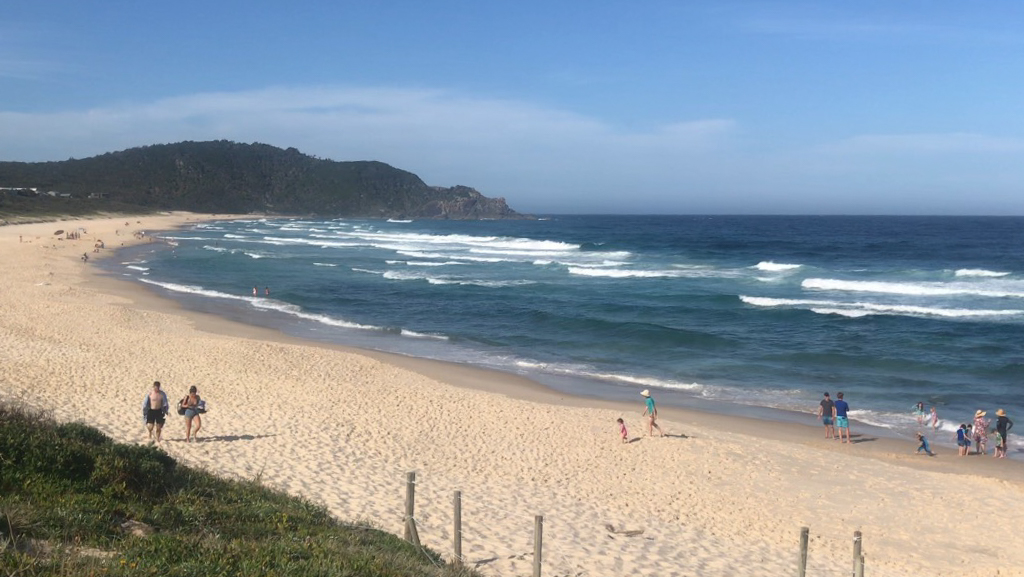
South Boomerang Beach looking North, photo by Lachlan Arnold
“We were sitting on the beach and this young guy came running up yelling, ‘my girlfriend has been pulled out in a rip, can you help?’”.
When the boy pointed out his girlfriend, Lachlan was shocked to see she was over 150 metres from shore. In the rough conditions, the boyfriend recognised he was unable to help by attempting to rescue her himself.
“We watched as he ran towards us, asking people if they could help as he made his way down the beach,” said Lachlan “but no one he asked could help.”
Lachlan and Max were staying at a house just a couple of hundred metres from where they were sitting on the beach. Immediately Max ran up to the house to grab a foam surfboard. A strong swimmer and surf lifesaver himself, Lachlan began to swim out towards the girl.
“Max and I got to the girl at about the same time. I was holding her up in the water and she was gone. She was probably 30 seconds from going under,” said Lachlan. “She was in the worst condition I’d ever seen anyone out in the water.”
Max had done an incredible job to sprint to get the board and complete the long paddle out so quickly to meet his dad. The pair were able to get the girl onto the board and Lachlan began paddling the girl back to shore while Max swam alongside.
“Miraculously we caught this wave that took us all the way to the beach – it really was the magic wave and the most welcome one I’ve ever caught,” recalls Lachlan.
Back on shore, the girl was completely exhausted so Max and Lachlan carried her up the beach where they called an Ambulance and performed checks of her condition.
“She could barely talk,” said Lachlan “and she said to me when she got her breath back, that she felt like she was breathing water.”
The proud dad said he had complete confidence in his young son throughout the rescue effort. “He knew exactly what to do and when to do it. He’s only 16 and he was just so calm and just having done his Bronze Medallion, it’s amazing.”
Lachlan said the surf life saving training and the family’s love of the ocean meant he wasn’t once worried for his son’s safety. “Max paddled out on the board and the surf was rough, but I didn’t once think he couldn’t do it,” he said.
Hidden women of history: Millicent Bryant, the first Australian woman to get a pilot's licence
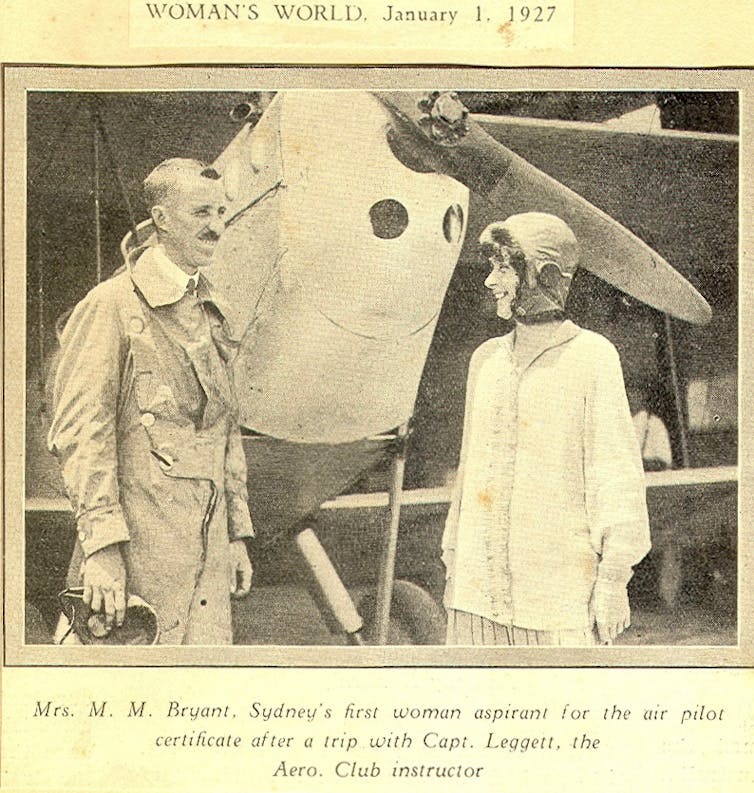
In this series, we look at under-acknowledged women through the ages.
Before the glamorous flyers of the 1930s like Amelia Earhart, “Chubby” Miller and Nancy Bird Walton, another woman opened the way to the skies — and were it not for a tragic twist of fate, her name might now be just as familiar.
Her name was Millicent Maude Bryant, and in early 1927, she became the first woman to gain a pilot’s licence in Australia. She was also first in the Commonwealth outside Britain.

A Boundary-Pusher Who Met An Untimely End
Millicent was born in 1878 at Oberon and grew up near Trangi in western New South Wales. Her family, the Harveys, moved to Manly for a period after a younger brother, George, contracted polio (one of the treatments was “sea-bathing”). She met and married a public servant 15 years her senior, Edward Bryant. They had three children but the couple separated not long before Edward died in 1926.
Later that year, Bryant began instruction with the Australian Aero Club at Mascot in Sydney. At the time, the site of the current international airport was just a large, grassy expanse with a few buildings and hangars.
Bryant was accepted by the Aero Club’s chief instructor, Captain Edward Leggatt (himself a noted first world war fighter pilot), soon after the club had opened its membership to women.
Even then, though, she was unusual: here was a 49-year-old mother of three taking up the challenge of flying which, in the 1920’s, was still as dangerous as it was exciting and glamorous.

She quickly progressed, ahead of two other younger, women students, and made her first solo flight in February, 1927. By this time, newspapers all around Australia were following her story, and in late March she took the test for the “A” licence that would enable her to independently fly De Havilland Moth biplanes.
She passed, and with the issue of her licence by the Ministry of Defence, Bryant was acclaimed as the first woman to gain a pilot’s licence in Australia.
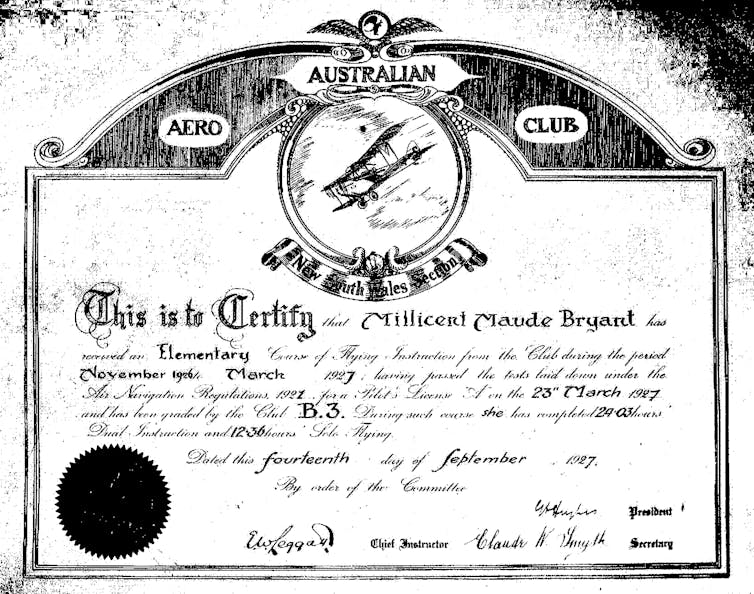
Why, then, isn’t she better known in our day? While Bryant immediately began training for a licence to carry passengers and flew regularly in the months that followed, it was her particular misfortune to step onto the Sydney ferry Greycliffe on its regular 4.14pm run to Watson’s Bay on November 3, 1927.
Less than an hour later, she was among 40 dead after the ferry was cut in half off Bradley’s Head by the mail steamer Tahiti. It was Sydney’s worst peacetime maritime disaster. Bryant was still only 49.
Her funeral two days later was attended by hundreds of people and accorded a remarkable aerial tribute, as the Wellington Times reported:
Five aeroplanes from the Mascot aerodrome flew over the procession as it wended its way to the cemetery. As the burial service was read by the Rev. A. R. Ebbs, rector of St. Matthew’s, Manly, one of the planes descended to within about 150 feet of the grave, and there was dropped from it a wreath of red carnations and blue delphiniums … Attached to the floral tribute was a card bearing the following inscription:
5th November, 1927. With the deepest sympathy of the committee and members of the Australian Aero Club — N.S.W. section.
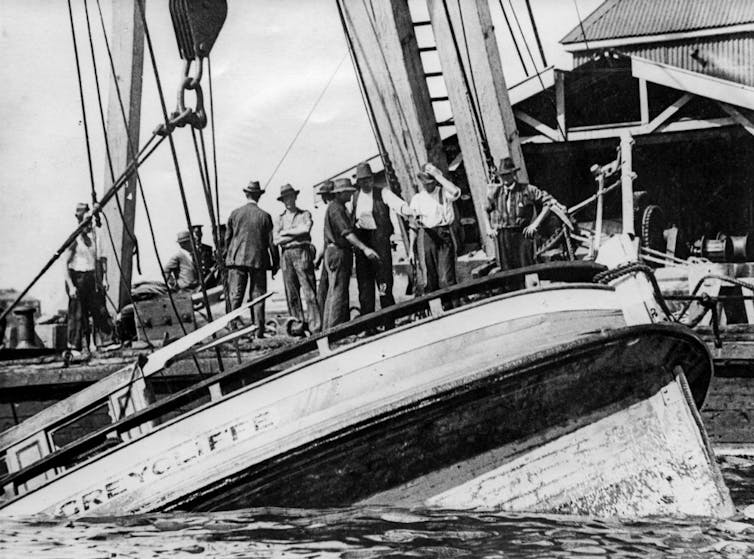
A Pioneer In Life As Well As The Sky
Bryant’s story quickly lapsed into obscurity. Fortunately, some 80 years later, the rediscovery in the family of a collection of letters and other writings has enabled Bryant’s life beyond her flying achievement to be rediscovered.
The letters were — and are still until they are added to the collection of Bryant’s papers in the National Library — held by her granddaughter, Millicent Jones of Kendall, NSW, who rediscovered them in storage at her home.
The main correspondence is a conversation with her second son, John, in England. It covers the period she was flying, though it only moderately expands on the flights recorded in her logbook.
However, her letters and writings reveal much more about Bryant herself, her relationships, her feelings and her leisure, business and political activities. And they make it apparent that she was as much a pioneer in life as well as in the sky.
For one, flying was not Bryant’s only unconventional interest. She was also an entrepreneur, registering an importing company in partnership with John, who went on to become a pioneer of the Australian dairy industry.
She opened a men’s clothing business, Chesterfield Men’s Mercery, in Sydney’s CBD. However, disaster struck when it was inundated with water mere weeks after opening, following a fire in the tea rooms upstairs.
Bryant then became a small-scale property developer, buying and building on land in Vaucluse and Edgecliffe. She’d been well tutored in this by her father, grazier Edmund Harvey (a grandfather of billionaire Gerry Harvey), whose own holdings eventually included a large part of the Kanimbla Valley west of the Blue Mountains.
An excellent horsewoman, Bryant was also an early motorist who had driven over 35,000 miles around NSW and who could fix her own car. She was a keen golfer and reader and even a student of Japanese at the University of Sydney.
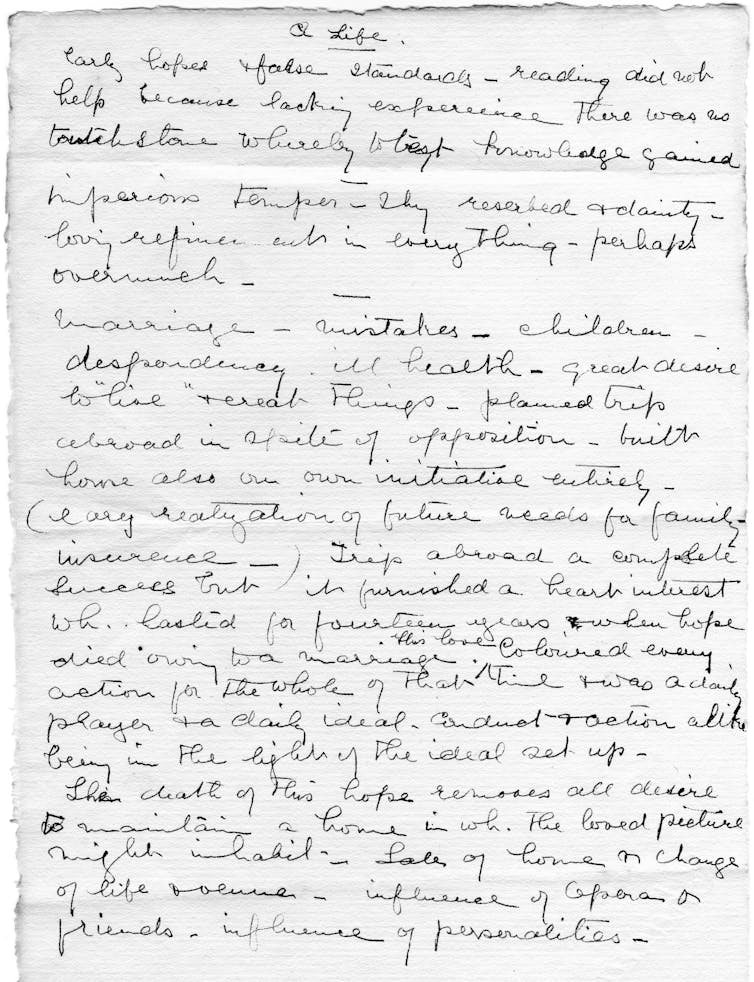
Several fragments of a family saga she planned to write, based on her own life, are among her papers. One sheet, entitled “A Life”, summarises in a series of rough notes rather more than she might have told anyone about her inner world.
Marriage – mistakes – children – despondency. Ill-health. Great desire to “live” and create things…
She notes that a trip abroad was a complete success but
it furnished a heart interest which lasted for fourteen years until hope died owing to a marriage.
This fragment provides some background to her taking, in her forties, the unusual step at that time of leaving her marriage and family home to start life afresh with her sons.
This was not long before she took her first flight, probably with Edgar Percival, a family friend and later a successful aircraft designer whose planes won air races and were noted for their graceful lines.
Vigour, Values And Conflicts
Growing up in the NSW inland late in the 19th century, Bryant would have begun with a fairly traditional view of what it meant to be a wife and mother.
However, her early life was also “free-spirited” (as one newspaper described her upbringing) and her determination to make decisions and shape her own life put her on a collision course with gender role expectations common at the time.
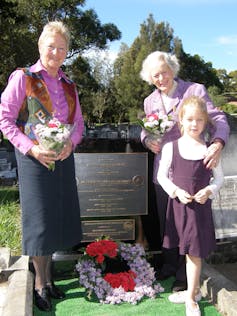
Learning to fly, especially in middle age, was a breakthrough she pursued perhaps even more keenly after being denied work with the Sydney Sun newspaper solely because she was married.
Bryant clearly came to hold strong ideas about what a woman could and couldn’t do, and her life shows a determination to make her own path, despite confronting obstacles that are still familiar in our own time.
Bryant is not just a figure in aviation history. Her life — spanning the colonial period, the newly-federated nation and the tragedies of World War I — came to reflect the vigour, values and conflicts of Australia in the early 20th century.
Read more: Hidden women of history: Wauba Debar, an Indigenous swimmer from Tasmania who saved her captors ![]()
James Vicars, Sessional Lecturer, University of New England
This article is republished from The Conversation under a Creative Commons license. Read the original article.
'WTF?': newly discovered ghostly circles in the sky can't be explained by current theories, and astronomers are excited
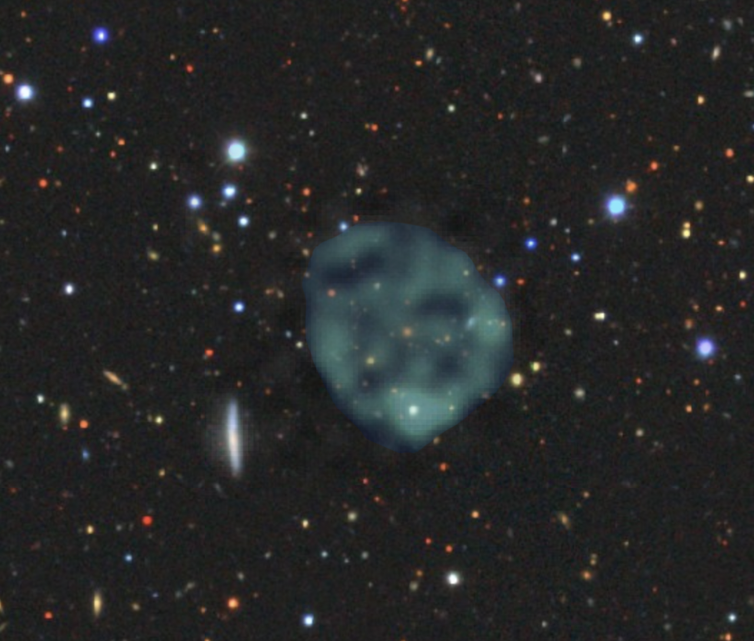
In September 2019, my colleague Anna Kapinska gave a presentation showing interesting objects she’d found while browsing our new radio astronomical data. She had started noticing very weird shapes she couldn’t fit easily to any known type of object.
Among them, labelled by Anna as WTF?, was a picture of a ghostly circle of radio emission, hanging out in space like a cosmic smoke-ring. None of us had ever seen anything like it before, and we had no idea what it was. A few days later, our colleague Emil Lenc found a second one, even more spooky than Anna’s.

Anna and Emil had been examining the new images from our pilot observations for the Evolutionary Map of the Universe (EMU) project, made with CSIRO’s revolutionary new Australian Square Kilometre Array Pathfinder (ASKAP) telescope.
EMU plans to boldly probe parts of the Universe where no telescope has gone before. It can do so because ASKAP can survey large swathes of the sky very quickly, probing to a depth previously only reached in tiny areas of sky, and being especially sensitive to faint, diffuse objects like these.
I predicted a couple of years ago this exploration of the unknown would probably make unexpected discoveries, which I called WTFs. But none of us expected to discover something so unexpected, so quickly. Because of the enormous data volumes, I expected the discoveries would be made using machine learning. But these discoveries were made with good old-fashioned eyeballing.
Read more: Expect the unexpected from the big-data boom in radio astronomy
Hunting ORCs
Our team searched the rest of the data by eye, and we found a few more of the mysterious round blobs. We dubbed them ORCs, which stands for “odd radio circles”. But the big question, of course, is: “what are they?”
At first we suspected an imaging artefact, perhaps generated by a software error. But we soon confirmed they are real, using other radio telescopes. We still have no idea how big or far away they are. They could be objects in our galaxy, perhaps a few light-years across, or they could be far away in the Universe and maybe millions of light years across.
When we look in images taken with optical telescopes at the position of ORCs, we see nothing. The rings of radio emission are probably caused by clouds of electrons, but why don’t we see anything in visible wavelengths of light? We don’t know, but finding a puzzle like this is the dream of every astronomer.
Read more: The Australian Square Kilometre Array Pathfinder finally hits the big-data highway
We Know What They’re Not
We have ruled out several possibilities for what ORCs might be.
Could they be supernova remnants, the clouds of debris left behind when a star in our galaxy explodes? No. They are far from most of the stars in the Milky Way and there are too many of them.
Could they be the rings of radio emission sometimes seen in galaxies undergoing intense bursts of star formation? Again, no. We don’t see any underlying galaxy that would be hosting the star formation.
Could they be the giant lobes of radio emission we see in radio galaxies, caused by jets of electrons squirting out from the environs of a supermassive black hole? Not likely, because the ORCs are very distinctly circular, unlike the tangled clouds we see in radio galaxies.
Could they be Einstein rings, in which radio waves from a distant galaxy are being bent into a circle by the gravitational field of a cluster of galaxies? Still no. ORCs are too symmetrical, and we don’t see a cluster at their centre.
A Genuine Mystery
In our paper about ORCs, which is forthcoming in the Publications of the Astronomical Society of Australia, we run through all the possibilities and conclude these enigmatic blobs don’t look like anything we already know about.
So we need to explore things that might exist but haven’t yet been observed, such as a vast shockwave from some explosion in a distant galaxy. Such explosions may have something to do with fast radio bursts, or the neutron star and black hole collisions that generate gravitational waves.
Read more: How we closed in on the location of a fast radio burst in a galaxy far, far away
Or perhaps they are something else entirely. Two Russian scientists have even suggested ORCs might be the “throats” of wormholes in spacetime.
From the handful we’ve found so far, we estimate there are about 1,000 ORCs in the sky. My colleague Bärbel Koribalski notes the search is now on, with telescopes around the world, to find more ORCs and understand their cause.
It’s a tricky job, because ORCS are very faint and difficult to find. Our team is brainstorming all these ideas and more, hoping for the eureka moment when one of us, or perhaps someone else, suddenly has the flash of inspiration that solves the puzzle.
It’s an exciting time for us. Most astronomical research is aimed at refining our knowledge of the Universe, or testing theories. Very rarely do we get the challenge of stumbling across a new type of object which nobody has seen before, and trying to figure out what it is.
Is it a completely new phenomenon, or something we already know about but viewed in a weird way? And if it really is completely new, how does that change our understanding of the Universe? Watch this space!![]()
Ray Norris, Professor, School of Science, Western Sydney University
This article is republished from The Conversation under a Creative Commons license. Read the original article.
Why there's a lot more to love about jacarandas than just their purple flowers
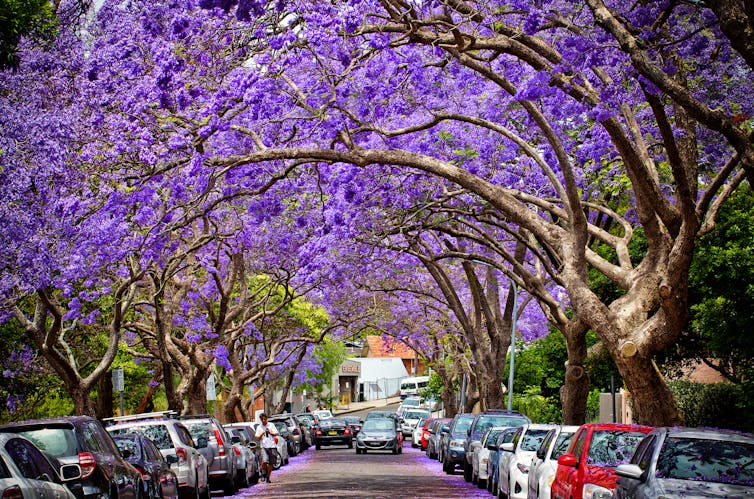
Every spring, streets across Australia turn purple with the delicate, falling flowers of jacarandas. This year, they’ll likely be flowering over Christmas.
The colour of the flowers is often debated – is it indigo, blue or purple? Well, it’s all of them and more as the colour ranges from deeper to lighter shades depending on the specimen, soils and season.
Read more: Spring is here and wattles are out in bloom: a love letter to our iconic flowers
Jacaranda is so well known to Australians and so well loved, that many of us think of them as a native. But the genus Jacaranda is actually native to South America, and the most common variety in Australia, Jacaranda mimosifolia, may be from an Argentine source.
For this reason, and others, there are many who don’t share the jacaranda love.

Festivals And Local Lore
Jacaranda festivals are a highlight of the year in many towns across Australia, including in Grafton, Applecross, Goodna, Camden, Woodville and Ipswich, to name a few.
The trees are even part of local lore at the University of Queensland, with students knowing of “purple panic” as they associate end of year exams with flowering.
California, Texas, Florida, southern Italy, Malta, Portugal, Spain and India boast stunning populations of jacaranda, too. I have seen them in Pretoria, South Africa’s capital, which is renowned for them, and in Gaborone, the capital of marvellous Botswana.
This is testament to how widely Jacaranda mimosifolia has been planted around the world. This is because, despite being a little frost sensitive, the tree is quite hardy when it’s young and copes with a wide range of soil and climatic conditions. And in hot climates, the trees provide an appealing, dappled shade — the flowers are a bonus.
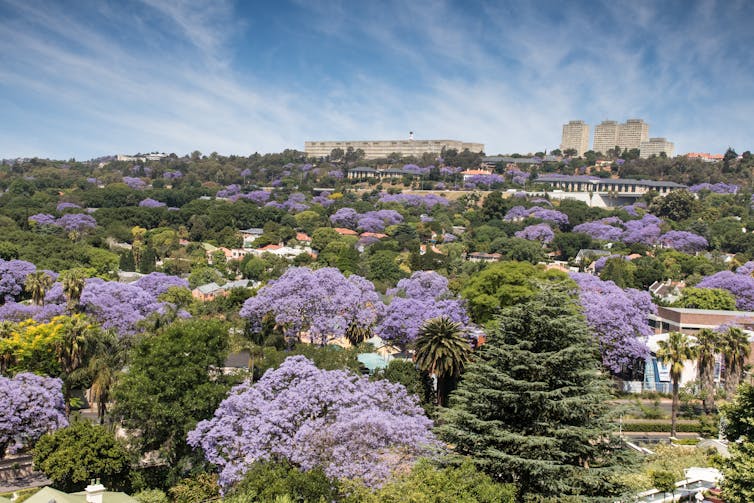
And yet, jacaranda is classified as threatened or vulnerable in its natural habitat. This is because the land it once and still occupies in South America is being rapidly converted for agricultural use.
It’s Not All About The Flowers
Jacaranda mimosifolia is known to attract some birds and insects such as the African honey bee and local and native honey-eaters. The species belongs to the family Bignoniaceae, and its members are largely distributed in tropical regions.
The Bignoniaceae family contains woody species alongside jacaranda, but many other members are “lianes”, the climbers you might associate with Tarzan swinging through the jungle.
Read more: Tree ferns are older than dinosaurs. And that's not even the most interesting thing about them
Jacarandas also have both soft and brittle wood and large, pod-like fruits which turn brown as they dry out.
These pods become almost woody and can rattle in the wind. This can be a bit disconcerting at first, but in mild wind it makes a soothing sound – a bit like a natural wind chime. And as Christmas approaches, some people gather the pods, decorate them and use them as ornaments.
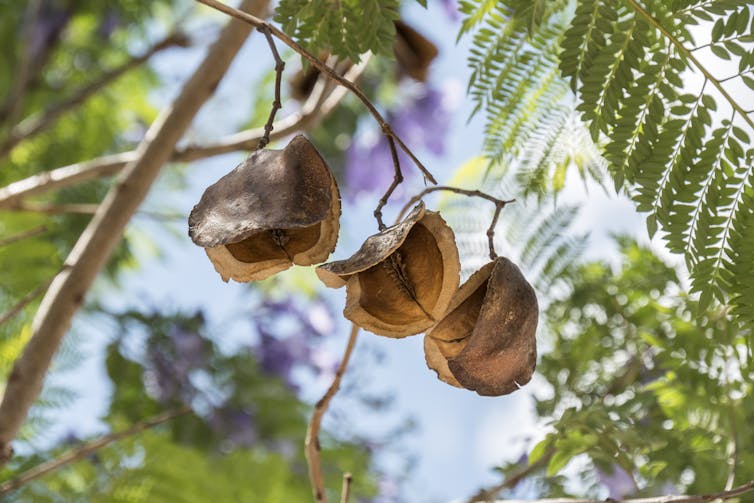
While the twigs and branches of the jacaranda break easily with an almost explosive crack, large pieces of wood can be used for wood turning, especially for bowls and handles. The brittleness of the wood also leaves jacaranda vulnerable to damage during strong winds, but usually only smaller branches and twigs are affected.
So What’s Not To Love? A Lot, Actually
Jacaranda has been declared an invasive weed in South Africa and parts of Australia, with the fine seeds within the woody fruits very easy to germinate. In Africa, it has proved very difficult to eradicate and can only be planted with official permission.
Its roots can be quite extensive and, depending on soil type, may damage paths and fences. This strong root system is one of the reasons jacaranda outcompetes local species, such as native grasses and wattles, and why very few other species can grow under it. In such situations, it can form dense seedling thickets.
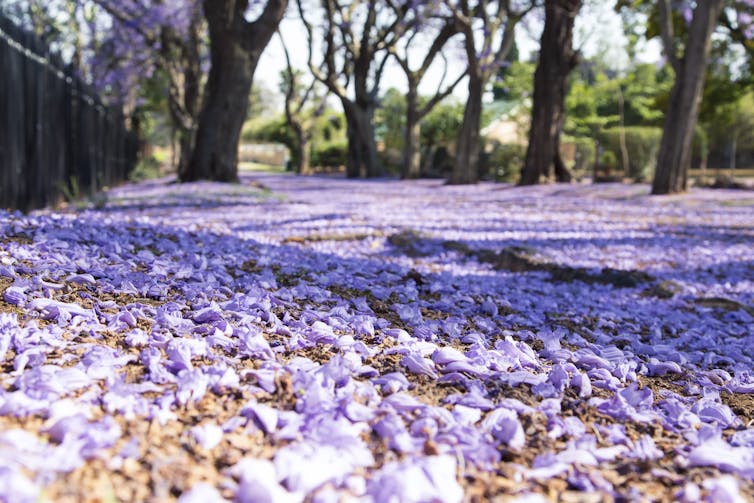
When it sheds its fine, feathery leaves, they have an amazing capacity to get into every nook and cranny, under roofs and into ceilings. While the living tree is fire retardant, I have seen how the leaves can form thick, tinder-dry mats which can be a fire hazard, and can completely fill or block gutters and drains, causing major damage to homes after heavy rain.
What’s more, their beautiful flowers are almost filmy when they shed, and if you add a little rain they can become very slippery.
What Does The Future Hold?
Whether you love them or hate them, the future for Jacaranda mimosifolia in urban Australia is bright, as it’s one of the species likely to do well under climate change as it grows well in warmer and drier places.
But in rural and regional Australia, greater care must be taken in places where it has the potential to become weedy.
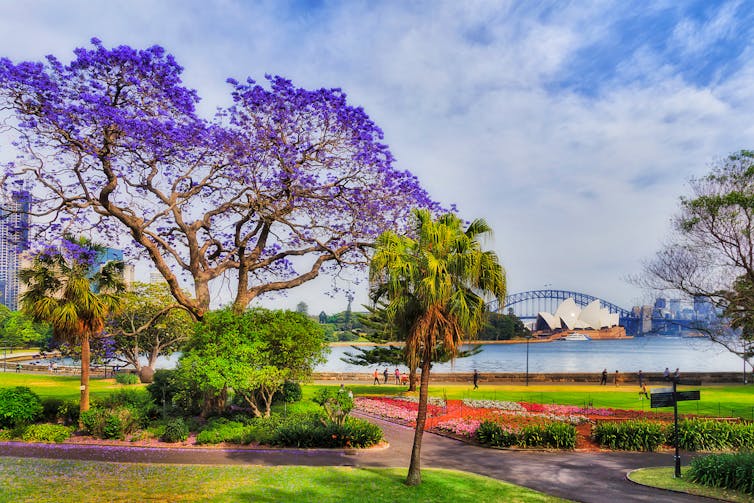
Perhaps the nursery industry will come up with fruitless or seedless varieties to resolve the problem, as it has with white cedar (Melia azedarach), whose fruits are so hard they represented a tripping hazard in cities.
Fruitless or seedless varieties of jacaranda would eliminate its potential weediness, ensuring it grows only where desired.
Regardless, we are likely to see the purple haze of jacarandas in flower over the Australian summer heat for many decades to come.
Read more: White cedar is a rare bird: a winter deciduous Australian tree ![]()
Gregory Moore, Doctor of Botany, University of Melbourne
This article is republished from The Conversation under a Creative Commons license. Read the original article.
Friday essay: the singlet — a short history of an Australian icon

There’s no denying the popularity of the singlet. The Chesty Bond, Australia’s best known singlet, has notched up more than 350 million sales. At last year’s Deniliquin Ute Muster, more than 3,970 blue singlets were counted.
Donned first as underwear, then for sport and later as the uniform of Australia’s working man, this simple garment has accrued complex cultural meanings over time.
Singlets have been famously worn by rock stars such as Jimmy Barnes and evolved into an item of gay dress.
Now worn by men and women alike, for sport, labour or leisure, they have a long and fascinating history.
From Underwear To Sportswear: 19th Century Singlets
The first singlets were concealed beneath clothing. The Workwoman’s Guide, a pattern book and instructional guide for making everyday clothing, was published in London in 1838. Though it contains the details for an extraordinary range of undergarments, it makes no mention of singlets.
Two years later, however, Mr Samuel Lyons advertised an auction of 40 cases of slop clothing in Sydney. Among the slops (relatively cheap, ready-made clothing) were 13 cases of plaid and velvet vests, short fitted coats called coatees and flannel singlets. This may be the earliest reference to the undergarment in an Australian newspaper.
Read more: A brief history of briefs – and how technology is transforming underpants
Australian gold-rush guides of the 1850s advised adventure-seeking migrants on the ideal clothing in which to seek their fortune. One helpfully suggested a digger’s outfit include two or three shirts, three pairs of trousers, a warm jacket and “two or three flannel singlets”.

These singlets formed a soft, warm, washable layer between men’s torsos and their outer clothing. However shirts, too, were considered underclothing at this time, serving a similar function.
In the second half of the 19th century, singlets emerged from beneath men’s clothes. Athletes, including pedestrians (competitive walkers or runners), wrestlers, wood-choppers and rowers, wore singlets openly for the first time.
This shocked some observers and intrigued others, who commented on the athletes’ magnificent physiques. Yet the benefit of wearing this simple, streamlined garment was clear. Singlets freed the shoulders and arms, enhancing movement.
An Australian Work Costume
Unsurprisingly, singlets were adopted by Australia’s working men shortly after.
Queensland’s colloquial term for the singlet, the “Jackie Howe”, takes its name from the shearer said to have bared his arms while setting new daily shearing records in 1892. In fact, it’s more likely he wore an undershirt. Later reports suggest he variously cut or tore the sleeves off his shirt, or perhaps did neither, merely inspiring another shearer to do so. At any rate, the name stuck, in Queensland at least.

Over the following decades, singlets became a distinctive element of the Australian work costume. During the first world war, soldiers were issued two singlets as part of their kit.
In the 1920s and ‘30s, close-fitting cotton “athletic” singlets were donned by timber cutters, construction workers and others involved in outdoor labour, most often paired with trousers and leather boots.
By the second world war, singlets were worn for sport and physical training and at rest.
Artist William Dobell, working for the Civil Construction Corps, painted several wartime images of workers clad in singlets, shorts and little else. One such painting, Concrete consolidation worker, Sydney graving dock (1944), depicts a man in shorts and a loose, white singlet, his body protected by a hat, gloves and work boots.

As this form of Australian masculinity took shape — strong, bronzed, well-built workers stripped down to their singlets — Bonds developed its Chesty Bond character.
He appeared in regular comic strips in Sydney’s Sun newspaper from March 1940. Slipping on a singlet exposed Chesty’s superhero-like form, but more importantly let his “great muscles work unimpeded”, as one cartoon put it. The image of Chesty Bond, with his distinctive jutting chin, powerful chest and rippling torso, still appears on the singlet’s packaging today.
Beyond The Working Man
The singlet’s symbolism had solidified as shorthand for the everyday working man by the mid-20th century. In the 1970s and ‘80s, pub-rock musicians drew on this connection, referencing the working-class roots of the music and their singlet-wearing fans.
Rose Tattoo favoured singlets in early promotional images to set off their tattooed arms.
Jimmy Barnes wore a white singlet in the film clip for Working Class Man (1985). Mark Seymour, front man of Melbourne’s Hunters and Collectors, was known for his high-energy, singlet-clad performances in hot, crowded venues.
At the same time, gay men began wearing singlets. The look, which first emerged in America, referenced tough, “macho” men. Combined with tight jeans and plaid shirts, singlets were an assertion of hyper-masculinity.
In the 1990s, singlets were recast again when underwear was embraced at gay clubs and dance parties. The singlet set off hard, smooth bodies, sculpted at the gym.
These examples point to the power of singlets to suggest a strong, rugged, muscular Australian masculinity. But singlets, too, have a darker side. Their ready association with hard-working and hard-drinking men has led to another particularly troubling, colloquial name: “the wifebeater”.
How you wear your singlet is a marker of class. White-collar workers wear singlets as often as their blue-collar counterparts, though theirs often remain unseen (at least at work), under business shirts and suits.

Women In Singlets
Women’s sleeveless undergarments, including chemises and camisoles, were worn in the 19th century and “ladies’ singlets” were advertised in Australian newspapers by the 1880s.
It took longer for women, though, to bare their arms in the range of settings that men did. Singlets were dotted through the crowds — on both young men and women — at popular music festivals like Sunbury in the early 1970s.

Melbourne photographer Rennie Ellis, a prolific documenter of daily life and by extension daily dress, captured many singlet-wearing women in his images, particularly during the 1980s.
In 2005 Akira Isogawa, one of Australia’s most creative contemporary fashion designers, remade the humble Bonds singlet, stitching an extravagant panel of vividly embroidered red and purple flowers on its front. The singlet had become high fashion.

Singlets are now as popular with women as with men. Our preoccupation with physical fitness and gym-ready bodies has seen a huge range of Australian and international brands enter the singlet market. Singlets made as active wear have special breathable, sweat-wicking properties.
For our Olympic athletes, singlets have been green and gold. The National Museum of Australia recently acquired 1969 silver medallist Peter Norman’s singlet, while other Olympic singlets appear in museum collections around Australia. But on the local oval or at the gym, in the pub or in the backyard, singlets of all colours reign.![]()
Lorinda Cramer, Postdoctoral Research Associate, Australian Catholic University
This article is republished from The Conversation under a Creative Commons license. Read the original article.
3 out of 10 girls skip class because of painful periods. And most won't talk to their teacher about it

More than one-third of young women in a nationwide survey said they missed at least one class, either at school or university, in the past three months due to menstrual symptoms, including pain and fatigue.
More than three quarters of young women said they had problems concentrating due to their period. Around half said they didn’t feel like they had performed as well on a test or assignment due to their symptoms.
We used a nationwide online survey to collect information from 4,202 teenagers and young women in Australia, aged 13 to 25, who were either at school or at tertiary education like university or TAFE.
More than half (60%) of the women in our survey said they wouldn’t feel comfortable speaking to a teacher or lecturer about how their period was affecting them.
How Period Pain Affects Education
Many young women experience menstrual symptoms. Almost three quarters report regular period pain, around half report fatigue, and more than one third report emotional changes such as mood swings. Studies show these menstrual symptoms can cause women to miss work or school and some previous studies in teenagers show it may potentially impact academic performance.
We wanted to understand how menstrual symptoms might be affecting young women in Australia with regard to their education, and how they manage these.
We asked young women about how often they got period pain and other menstrual symptoms, how it impacted their attendance or classroom performance, and explored how useful they found the sexual and reproductive education they had previously received.
In our survey, nine out of ten young women reported having had period pain in the past three months, and half reported pain every month. This is similar to previous findings in teenagers in Australia.
Read more: Period pain is impacting women at school, uni and work. Let's be open about it
Their pain scores, which tended to be moderate to severe for most, didn’t change as they got older.
More than one-third of young women said they missed at least one class in the past three months due to their menstrual symptoms. This was almost identical no matter if they were at school or at university.
The negative impacts of periods also included missing sport and social activities. But more than half (60%) of young women said they wouldn’t feel comfortable speaking to a teacher or lecturer about how their period was affecting them.
Pain was the biggest factor in predicting how much their education would be affected, with higher pain scores having a much greater negative impact. This is a concern as it often occurs at a crucial time in their academic lives during their final schooling years. Absenteeism at this time can have long-term consequences due to exams and assignments in the senior years often determining which courses can be studied at tertiary education.
Many Accepted Pain As ‘Normal’
Most of the young women in our study didn’t seek medical advice for their pain, even when it was severe. This is similar to what has been found in the past.
As their pain got worse they were more likely to think it was abnormal but weren’t any more likely to seek medical attention. This is probably due, at least in part, to the fact most young women think pain is normal and they just need to put up with it.
Unfortunately, this belief can often be reinforced when they speak to a medical professional.
Read more: Health Check: are painful periods normal?
Only about half of young women at school had heard of endometriosis — a chronic condition in which cells similar to those that line the uterus grow in other parts of the body. It can cause significant pain, fatigue and reproductive issues.
Only about half of young women said they would seek medical advice if they had pelvic pain when they didn’t have their period. This is despite over half (55%) reporting they did experience pelvic pain (pain similar to their period but when not menstruating) at least once a month.

Severe period and pelvic pain when not menstruating are very common early signs of chronic pelvic pain (such as endometriosis), and delays in diagnosis may worsen outcomes for young women.
Read more: 1 in 10 women are affected by endometriosis. So why does it take so long to diagnose?
Women Need Better Education
Education on menstrual health is incorporated into the Australian Foundation to Year 10 Health and Physical Education (HPE) curriculum. This positions health and physical education teachers as critical in providing students with evidence-based information in a relevant, timely and age-appropriate manner.
Yet the extent to which this is occurring in schools is unknown. Research reports Australian teachers are uncomfortable addressing menstruation. This often results in periods being taught as a negative and troublesome part of growing up.
The young women we surveyed highlighted their schools’ shortcomings in educating them on how to manage period pain. One 16-year-old Victorian student said:
There was no practical information such as relieving symptoms and the use of sanitary items, only the biological effect on the body such as how hormones come into play. Personally that was not useful and I can’t remember much about it.
The young women saw a lack of support for period pain during their education and the negative impacts this may have. An 18-year-old student from Western Australia said:
In particular, no advice was given on dealing with pain (mine ended up being extreme) or what the process (if any) was at school for having menstrual pain taken seriously and treated as a consideration in test writing or sport class.
Teachers need to be more aware of potential impacts of period pain on education outcomes. And the curriculum must be expanded to focus on mitigation strategies for period pain.
There are some promising menstrual education programs, both in person and online, that have been developed to tackle these shortcomings, including some that also include parents and boys. Currently these programs are often ad-hoc, and need to be adopted as a consistent part of the school curriculum.
It is critical menstruation and period pain transcend being a girl’s or women’s issue alone and include all genders, as well as parents and caregivers, who are often called on to support and inform young people.![]()
Mike Armour, Senior research fellow, Western Sydney University; Kathryn Holmes, Professor of Education, Western Sydney University, and Kelly Ann Parry, Sessional Lecturer, Western Sydney University
This article is republished from The Conversation under a Creative Commons license. Read the original article.
Born to be wild — revelling in the design and desire of the motorcycle

Review: The Motorcycle — Art, Design, Desire at Queensland Art Gallery of Modern Art
Motorcycles are such a guy thing, right? Think Steve McQueen in The Great Escape, Arthur Fonzarelli in television’s Happy Days and Daniel Craig’s James Bond. All blokes, exuding controlled coolness, astride impressively loud, throbbing engines.
Yet in Motorcycles — Design, Art, Desire, this summer’s blockbuster exhibition at Queensland Art Gallery of Modern Art (QAGoMA), there is a mean red motorcycle that was ridden by the fastest Australian woman on two wheels, Kim Krebs.
How fast did she go? The numbers are hard to get your head around: 244 miles per hour. That’s miles. In kilometres that is a tick under 400 per hour. Think of the legal limit you can drive along the highway and multiply it by four … and she is still attempting to go even faster.
Kreb’s record breaking ride is one of a hundred motorcycles in the exhibition, drawn from collections all over the world by curators Charles M. Falco and Ultan Guilfoyle.

Read more: Celebrating the feminist Holden
Motorcycles? In An Art Gallery?
This is a niche category exhibition that follows similar QAGoMA shows such as the fashion house Valentino Retrospective, Past/Present/Future (2010), California Design: Living in a Modern Way (2013-14) and Marvel: Creating the Cinematic Universe in 2017.
The Marvel exhibition drew over a quarter of a million visitors (I confess I had season tickets and still miss seeing Hulkbuster each week) clearly indicating such shows, however singular, have broad appeal.
QAGoMA director Chris Saines says the gallery runs with a broad definition of what constitutes modern culture. Accordingly, people who ordinarily would not visit art galleries beat a path to this one for specialised exhibitions. Niche shows appeal to specific demographics, who have a rusted on dedication to their passion.
With the opening of Queensland’s borders following coronavirus restrictions perfectly coinciding with this exhibition, there will surely be a steady stream of two-wheeled devotees making their way to Brisbane.
But this show will also educate and inform those with an interest in design, modern history, popular culture, and art, who are willing to learn something new, and like me, may start to see motorcycles in a different way.
Read more: What evolution and motorcycles have in common: let's take a ride across Australia
From Original Steampunk To Future Motors
Encompassing early models from the Victorian era (bicycles with an engine strapped to them, very steampunk), through the mid-20th century’s chrome muscle machines, to sleek concept bikes of the future powered by electricity, this exhibition covers the motorbike’s 150-year history.
All the big names are here: Norton, Triumph, BSA, Ducati, Honda, Kawasaki. There are also a number of bespoke style designers, including Australia’s Deus Ex Machina, whose ultracool Drover’s Dog (2009) accommodates a surfboard on its side.

Exhibition designer Michael O’Sullivan has used the gallery’s expansive ground floor to great effect. The angular architecture reflects and amplifies the stars of the show, setting this exhibition apart from a mere motor show exposition.
Each item is treated like a fine art object, gleaming chrome lit to perfection, positioned just so. Information panels inform the curious lay person and digital projection screens show great motorcycle movie moments to seal the deal.
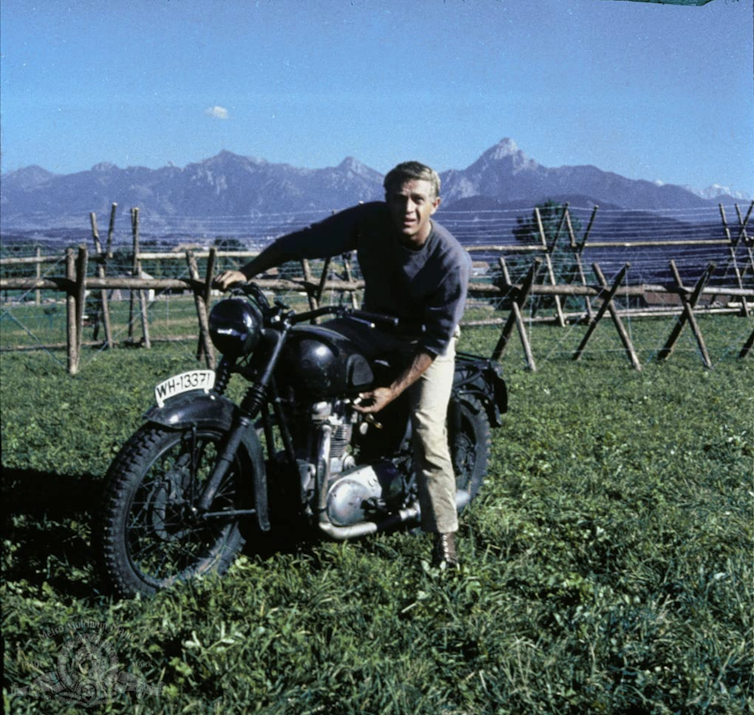
There are of course elements within the design of the motorcycles that reflect fine art values of their era, most notably German Bauhaus and Art Deco influences, when motorcycles morphed from the simple functionality of economical transportation to aesthetically pleasing status symbols.
Read more: Explainer: who owns the copyright to your tattoo?
Slow Riders And Low Riders
The oldest known motorcycle, and the first that exhibition visitors see, was developed by Frenchman Louis-Guillaume Perreaux. Steam-powered, the 1871 model had a top speed of 14 kilometres per hour and being mainly made of timber, would not have been a comfortable ride.
Contrast this with the cruiser motorcycles a century later, most notably by Harley-Davidson, when riders reclined on customised bikes, such as the almost impossibly elongated Chopper, just like the one ridden by Dennis Hopper and Peter Fonda in Easy Rider (1969).

On the eve of the exhibition, land racer Krebs described what it feels like to ride in excess of 200 miles per hour. She spoke of feeling a kind of serenity, as she travels so fast across the salt plains that the roar of her turbo-charged engine is left far behind her.
“What are you aiming for?” a journalist asked her.
“I am aiming for forever”, she replied.
Just like something an artist would say.
The Motorcycle — Art, Design, Desire is showing at QAGOMA until 26 April 2021.![]()
Alasdair Macintyre, Associate lecturer visual arts, artist, PhD candidate, Australian Catholic University
This article is republished from The Conversation under a Creative Commons license. Read the original article.
Free General Admission To Upgraded Australian Museum
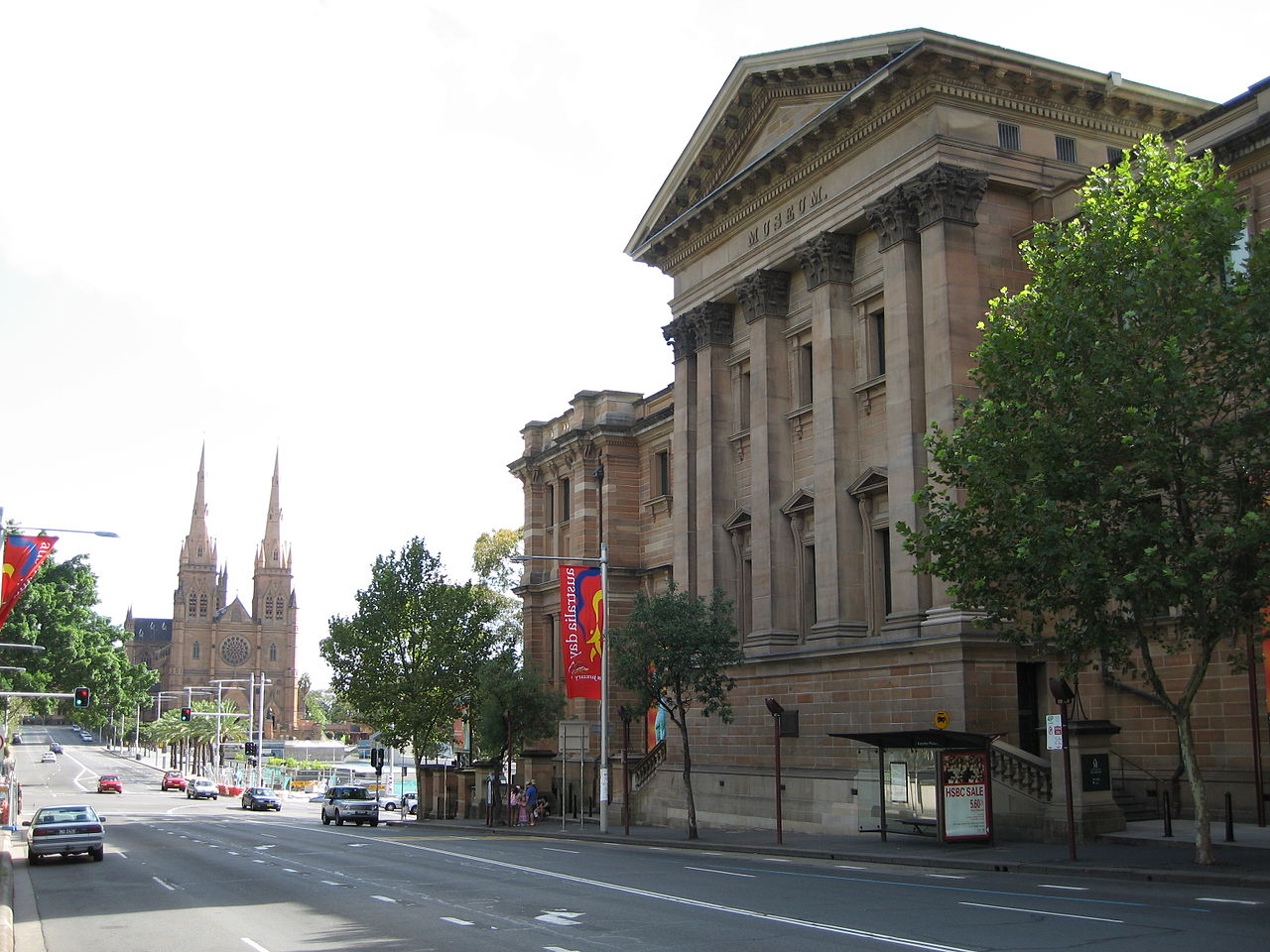
'Schoolies 2020 - But We Must Be COVID-Safe': Police Warn School Leavers Ahead Of End Of School Celebrations
‘This year is different, this is not schoolies as you know it’ – that’s the message from senior officers at Tweed/Byron Police District ahead of 2020 end of school celebrations.
School leavers from across NSW and interstate are due to arrive in Byron Bay and other parts of Northern NSW from today (Friday 20 November 2020), and are expected to stay into December.
While there are no formal events associated with ‘Schoolies 2020’ occurring in the Byron Bay area, police are expecting thousands of school leavers to descend on the coastal town to mark the end of their 13 years of schooling.
In anticipation for the large crowds, Tweed/Byron Police District will conduct an extensive and high-visibility operation for the duration of the ‘schoolies’ period, assisted by the Richmond Police District and other Northern Region commands, the Public Order and Riot Squad, Northern Operational Support Group officers, the Mounted Unit, the Police Dog Unit, Traffic and Highway Patrol, and the Youth Command and PCYC.
Tweed/Byron Police District Commander, Superintendent Dave Roptell, said this year’s celebrations must be conducted in a COVID-safe environment, with officers to enforce all current Public Health Orders and conduct regular business compliance checks.
“We know this has been an extremely tough year for HSC students, and we appreciate that school leavers want to have a memorable time. However, these are not normal times, so we ask anyone coming to the far North Coast to be respectful – we have come this far in managing COVID-19 in our regional communities, let’s not undo all our hard work now,” Supt. Roptell said.
“With the NSW and Queensland border now re-open to regional NSW, Byron Bay is included in that zone. And with the border between NSW and Victoria to re-open early next week, we are expecting thousands of school leavers to come to our area.
“The NSW Police Force continues to work closely with health officials and other government agencies, businesses and the community to manage the COVID-19 crisis and minimise the spread of the virus.
“In saying that, we have a very clear message to those choosing to come to Byron in 2020 – this year is very different, there will be no large gatherings, no dance parties in the park. Social distancing is the new normal, and we all have to do our bit to stop the spread.
“The risk of community transmission is still present here in Australia, and with people from interstate expected to come to Byron, school leavers need to be extremely aware of the dangers of COVID-19.
“Public Health Orders currently state that no more than 20 persons can be inside a home at any one time – this includes short-stay accommodation. The orders also state that up to 30 people can be gathered in a public space at any one time, this includes places such as parks, beaches, etc.
“While we will be enforcing the Public Health Orders, police want to remind school leavers that we aren’t here to ruin the fun – our officers are here to protect you and keep you safe; approach police or authorities if you are in danger, if you feel threatened or you are a victim of any type of crime.
“Not only will police be ensuring Public Health Orders are being followed, but officers will be targeting drug and alcohol-related crime, as well as anti-social behaviour.
“Drugs and alcohol impairs your judgement and can lead to risky behaviours or choices which can impact the rest of your life. Know your limits and look out for your mates.
“With the increase in activity in the Byron town centre, we are urging all visitors and locals alike to plan ahead; those not joining in the celebrations are asked to watch out for increased pedestrian activity and keep an eye out on the roads.
“As always, if you’re planning on drinking – you need a Plan B to get yourself home,” Supt. Roptell said.
The NSW Police Force continues to work closely with the Schoolies Safety Response agencies, which include Byron Youth Service and Red Frog volunteers, alongside all health officials and other government agencies, businesses and the community to minimise disruption and maintain a COVID-Safe environment.
For all information related to schoolies during COVID-19, visit the website: https://www.schoolies.com/covid-19-faq
Anyone who has information regarding individuals or businesses in contravention of a COVID-19-related ministerial direction is urged to contact Crime Stoppers: https://nsw.crimestoppers.com.au. Information is treated in strict confidence. The public is reminded not to report crime via NSW Police social media pages.
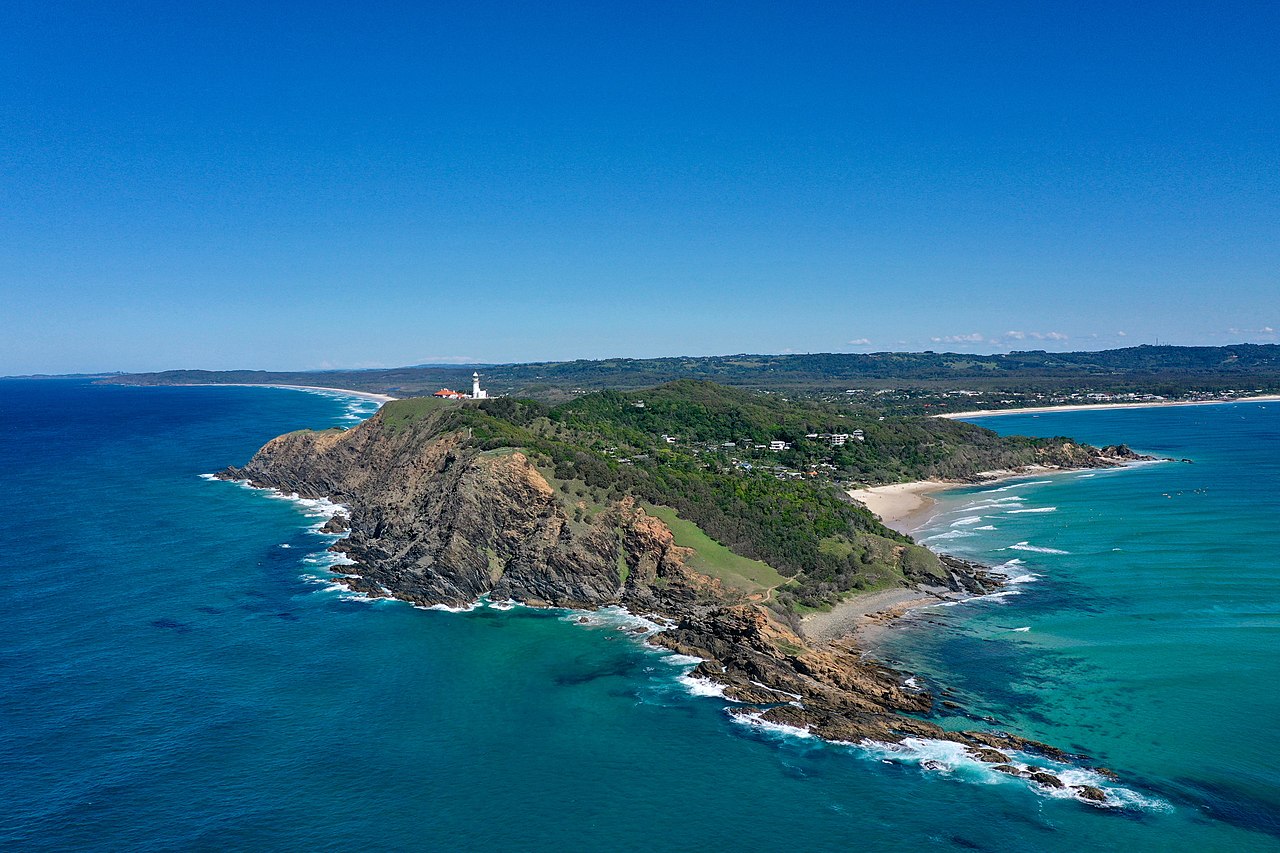
Byron Bay Lighthouse, Beach and Hinterland Aerial Shot by K Pravin
Program Helps Skill Up School Leavers Over Summer
The NSW Government's Skilling for Recovery program offers fee-free training places for school leavers, young people and job seekers.
Hundreds of fee-free training courses are now available for school leavers, young people and job seekers, as part of the NSW Government’s Skilling for Recovery initiative.
Premier Gladys Berejiklian said the courses came from the $320 million committed to delivering 100,000 fee-free training places across the state.
“There are more than 100,000 fee-free training places available for people in NSW as the workforce looks to reskill, retrain and redeploy in a post-COVID-19 economy,” Ms Berejiklian said.
“It doesn’t matter if you are a school leaver or looking for a new career path, I encourage everyone impacted by the pandemic to see what training options are available to them.”
Minister for Skills and Tertiary Education Geoff Lee said enrolments were now open for in-demand skills leading to career pathways in areas such as aged care, nursing, trades, IT, community services, logistics and accounting.
“We are not training for the sake of training, we are training for real jobs with real futures and equipping the people of NSW with the skills they need to thrive in a post-pandemic economy,” Mr Lee said.
“There are hundreds of providers right around NSW who are ready to deliver this important training.”
As part of this Skilling for Recovery initiative, school leavers have the unique opportunity to experience a range of skills to find out what suits their passions using the Summer Skills program.
Minister for Education Sarah Mitchell said some Year 12 school leavers were still deciding what they wanted to do next.
“In designing the Summer Skills program, the NSW Government has ensured the training on offer is aligned to local industry needs,” Ms Mitchell said.
“We need to provide opportunities that help the 2020 Year 12 school leaver cohort to find their feet during these uncertain times. That’s why we’re delivering practical, bite-sized and fee-free training opportunities this summer.”
The Summer Skills offered will cover a range of industries including agriculture, construction, conservation, fitness, engineering, coding, communication and digital literacy.
You can find further details of the courses on offer as part of Skilling for Recovery and the Department of Education Summer Skills program on the respective websites.
Octogenarian Snapper Found Off Australia Becomes Oldest Tropical Reef Fish By Two Decades
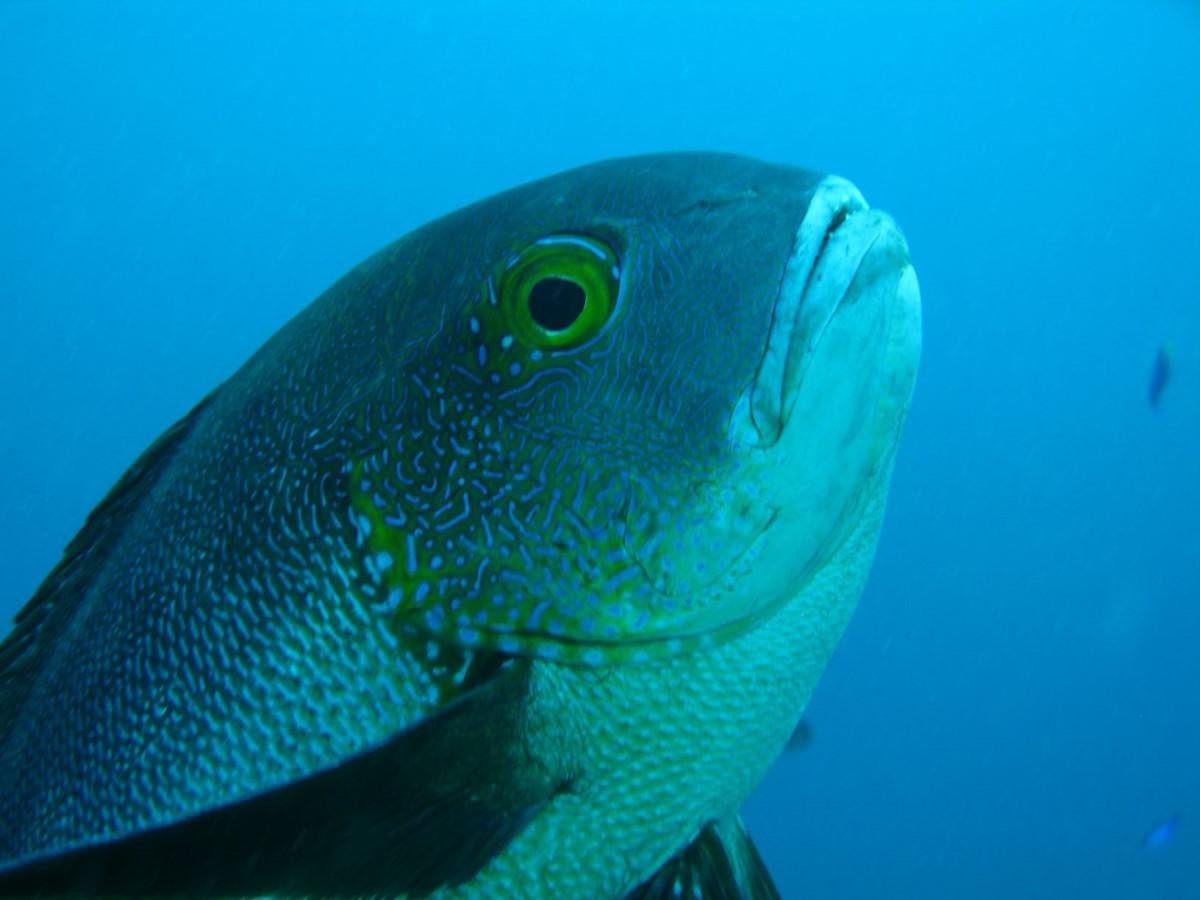
Genes Unlock Clues To The Evolution And Survival Of The Great Barrier Reef
Children With Dyslexia Show Stronger Emotional Responses
Additional $132.2 Million For Aged Care Covid Response
- $35.5 million to provide access to Medicare subsidised individual psychological services under the Better Access to Psychiatrists, Psychologists and General Practitioners through the MBS (Better Access) initiative until 30 June 2022 and to evaluate Better Access.
- $12.1 million for additional individual allied health sessions under Medicare chronic disease management plans.
- $15.7 million for allied health group services for residents living in facilities affected by COVID-19 outbreaks.
- must be a designated member of the nursing staff which has completed (or initially is in the process of completing) an identified IPC course;
- is employed by the Approved Provider and reports to the Approved Provider, which retains overall responsibility for IPC in accordance with its obligations under the Aged Care Act 1997;
- observes, assesses and reports on IPC of the service, and assists with developing procedures/provides advice within the services; and
- must be engaged onsite for each facility and dedicated to that facility; and may have a broader role within the facility and could be an existing member of the nursing staff.
- Ongoing assessment of the preparedness of aged care providers.
- Auditing of State and Territory emergency response capabilities and planning for the standing up of joint health aged care emergency responses.
- Prioritisation of additional face-to-face infection prevention and control training for residential aged care providers.
Seniors Stories Volume 6 (2020) Now Available
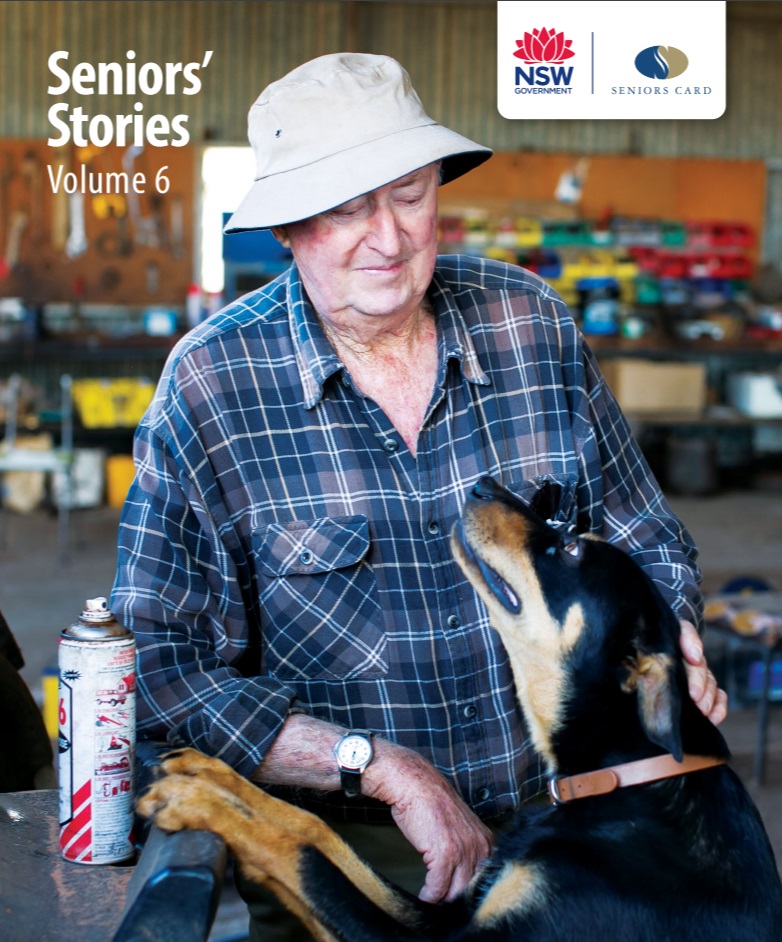
Hot Deals Keep Seniors Cool For Christmas
CSIRO Solution Creates Smarter, Safer Homes For Independent Seniors
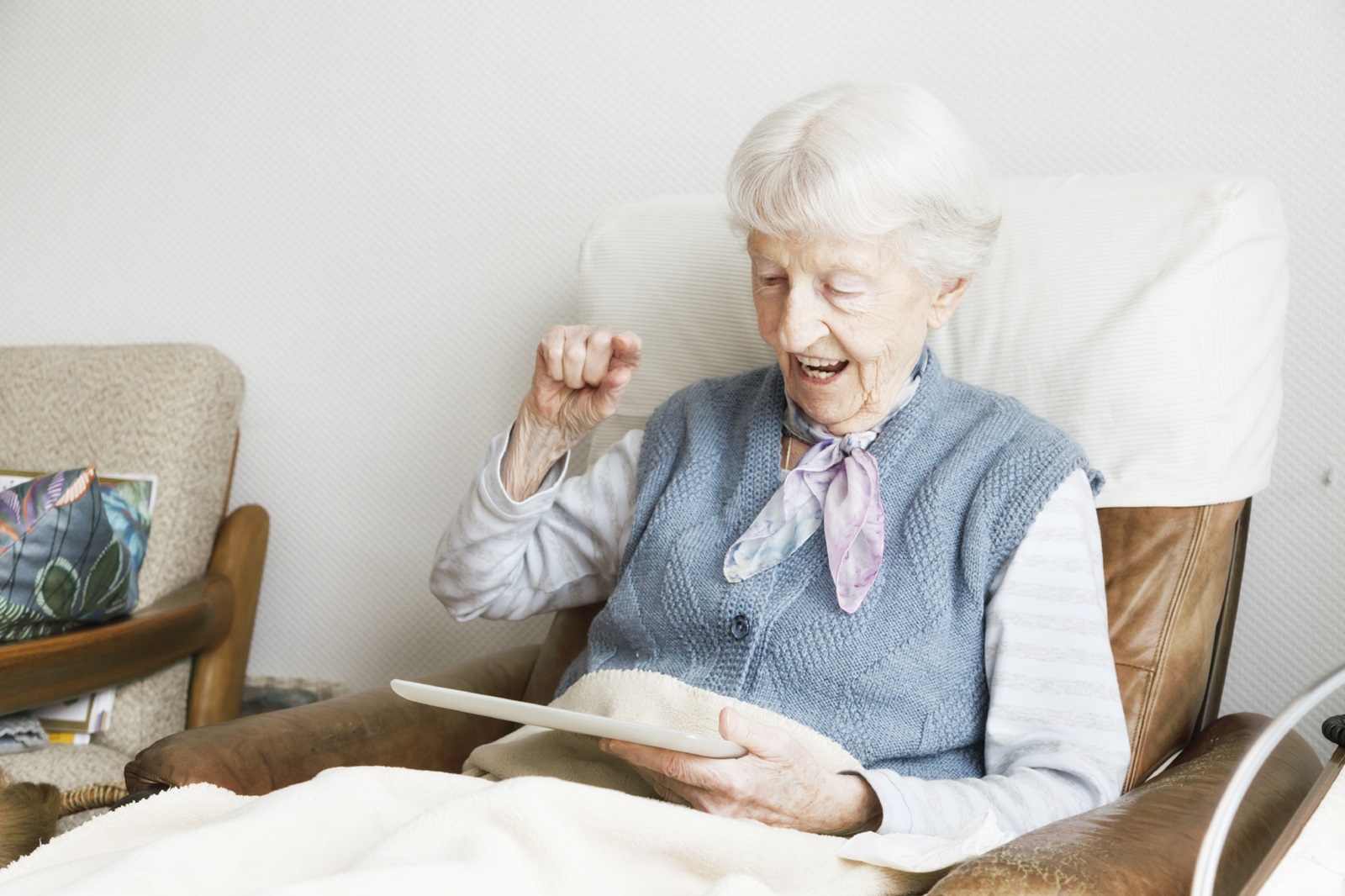
Drug Reverses Age-Related Mental Decline Within Days
- Frontotemporal Dementia
- Alzheimer's Disease
- Amyotrophic Lateral Sclerosis (ALS)
- Age-related Cognitive Decline
- Multiple Sclerosis
- Traumatic Brain Injury
- Parkinson's Disease
- Down Syndrome
- Vanishing White Matter Disorder
- Prion Disease
$10m Gift Sees UNSW Launch Critical Health Engineering Institute
.jpg?timestamp=1606870329246)
New Chair Of Asia Society Australia Has Lasting UNSW Sydney Links
.jpg?timestamp=1606870640825)
Keyhole Wasps May Threaten Australian Aviation Safety
Disclaimer: These articles are not intended to provide medical advice, diagnosis or treatment. Views expressed here do not necessarily reflect those of Pittwater Online News or its staff.